Toy games really help with understanding poker theory IMO.
This first toy game I want to cover is a range of nuts and air versus a range of marginal hands (bluffcatchers):
- OOP player has AA, 54o, 53o, 52o, 43o, 42o, 32o
- IP player has KK
- Flop is 888 rainbow
- Pot is 50 and stacks are 950
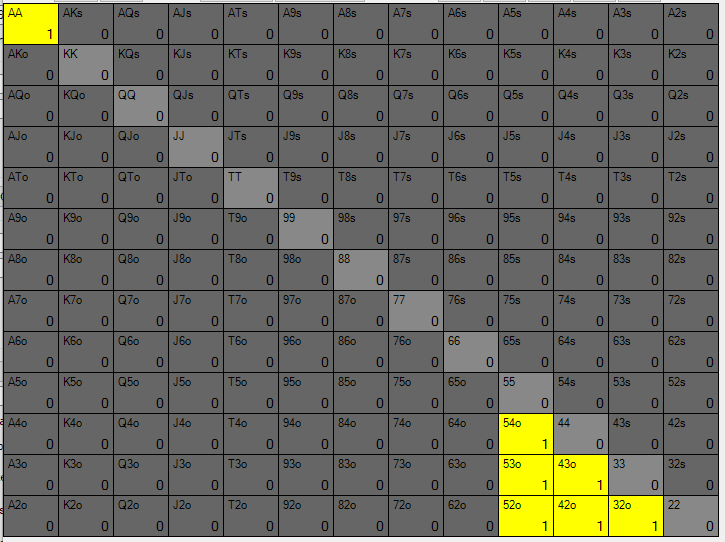
Preflop OOP Range
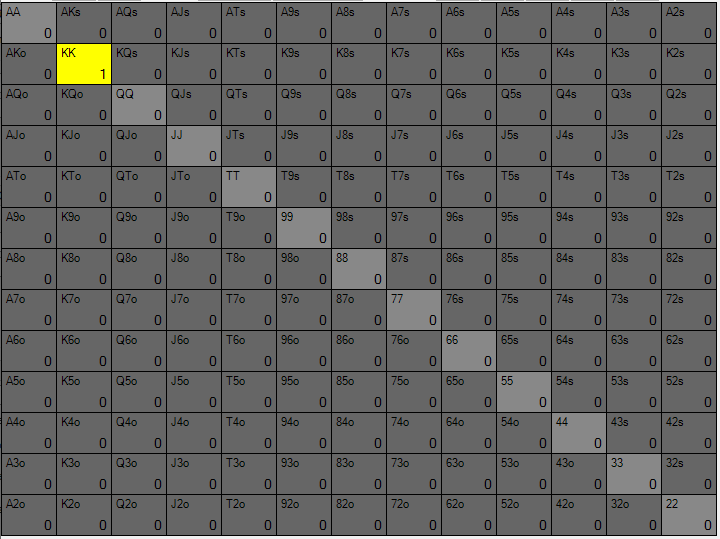
Preflop IP Range
I will go over the full strategy and also some math.
I assume the reader knows basic poker concepts like:
- EV and equity
- alpha value / pot odds
- Betting with the right ratio of nutted hands and bluffs to make our opponent indifferent to calling with his bluffcatchers
Flop High-Level Summary
On the flop, we are betting with a balanced range of AA as the nuts and mixing in bluffs with equal amounts from our offsuit trash. The solver uses the same frequency for all the bluffs because it has no preference because none of them have any blocker properties.
Let’s take a look at the two strategies on the flop:
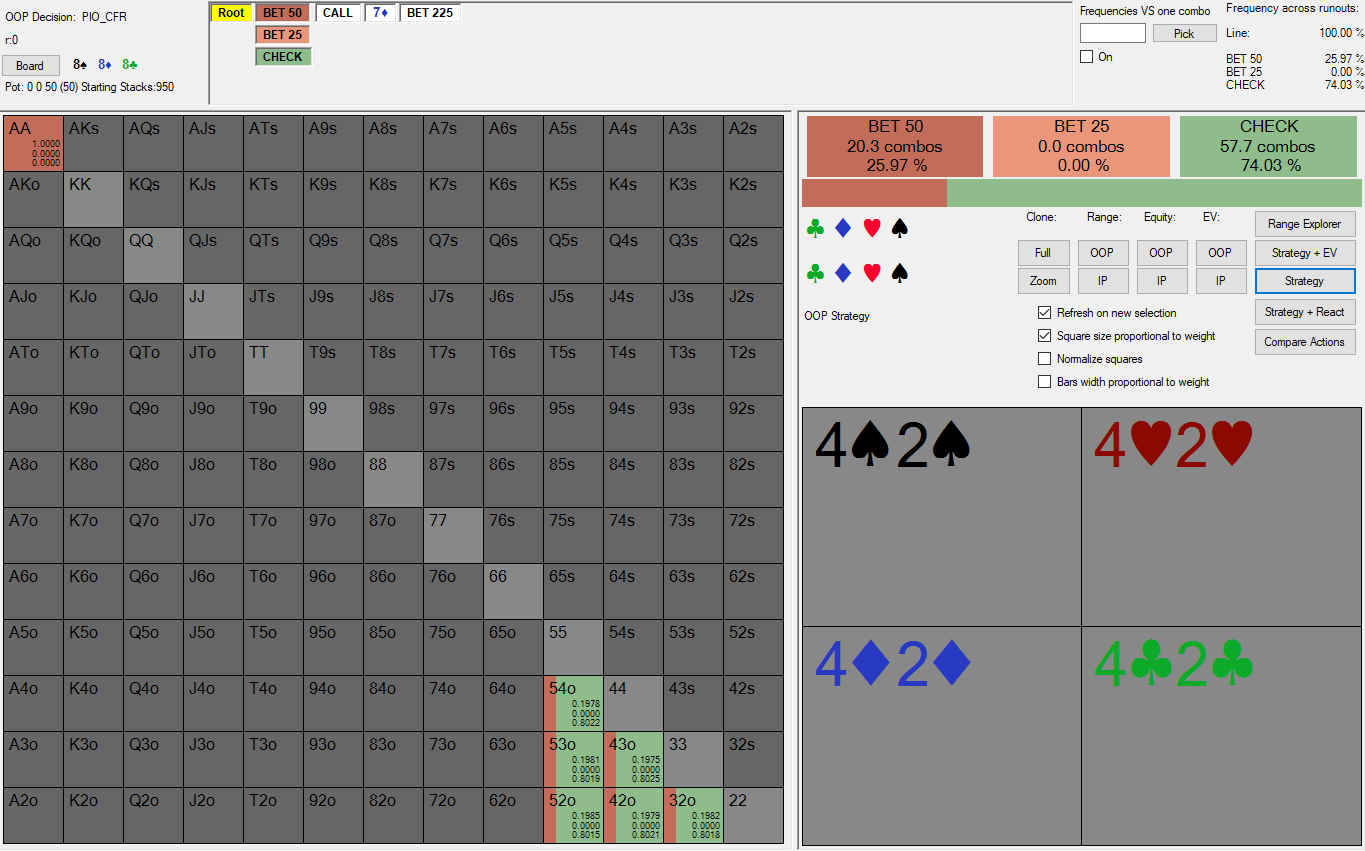
Flop OOP Strategy
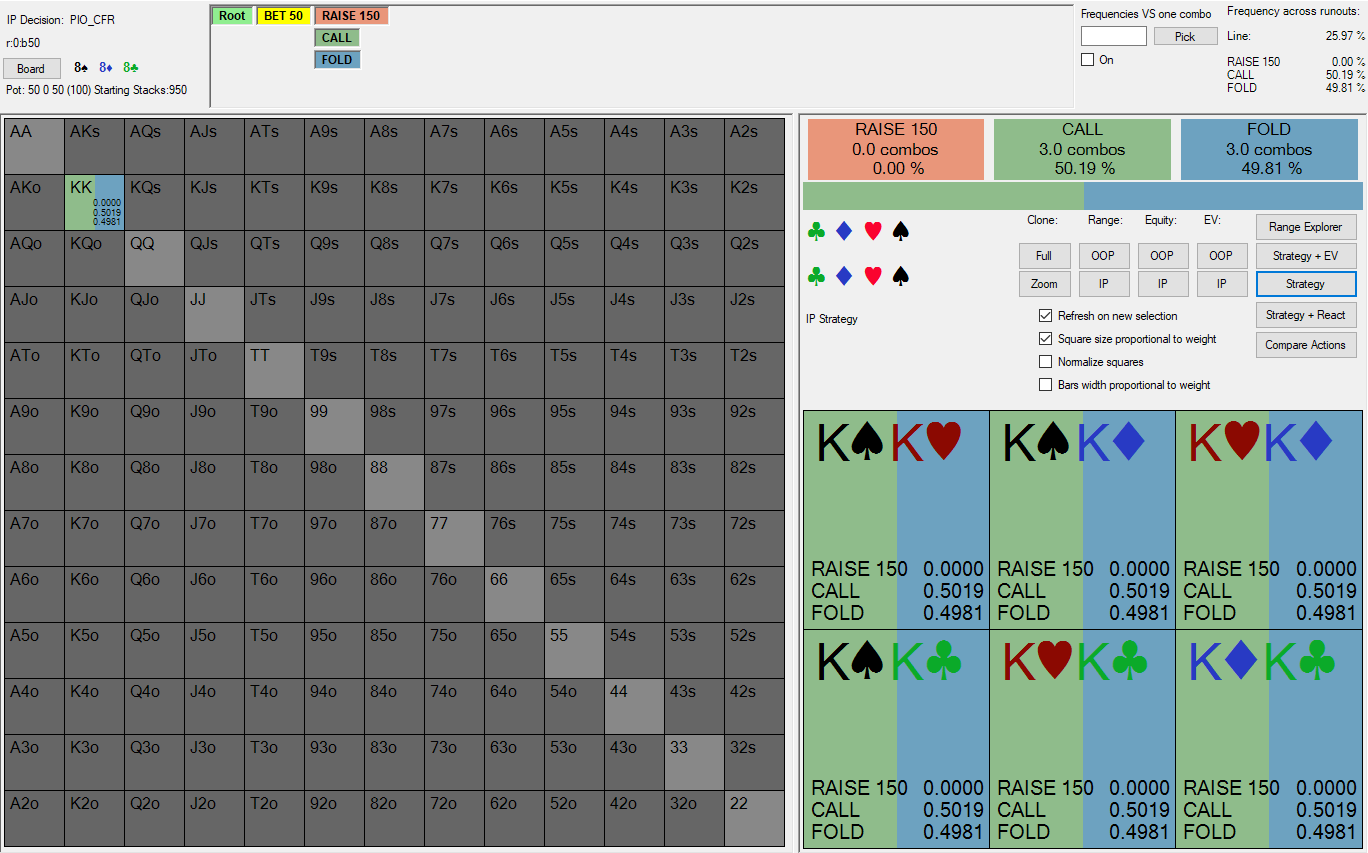
Flop KK strategy against OOP bet
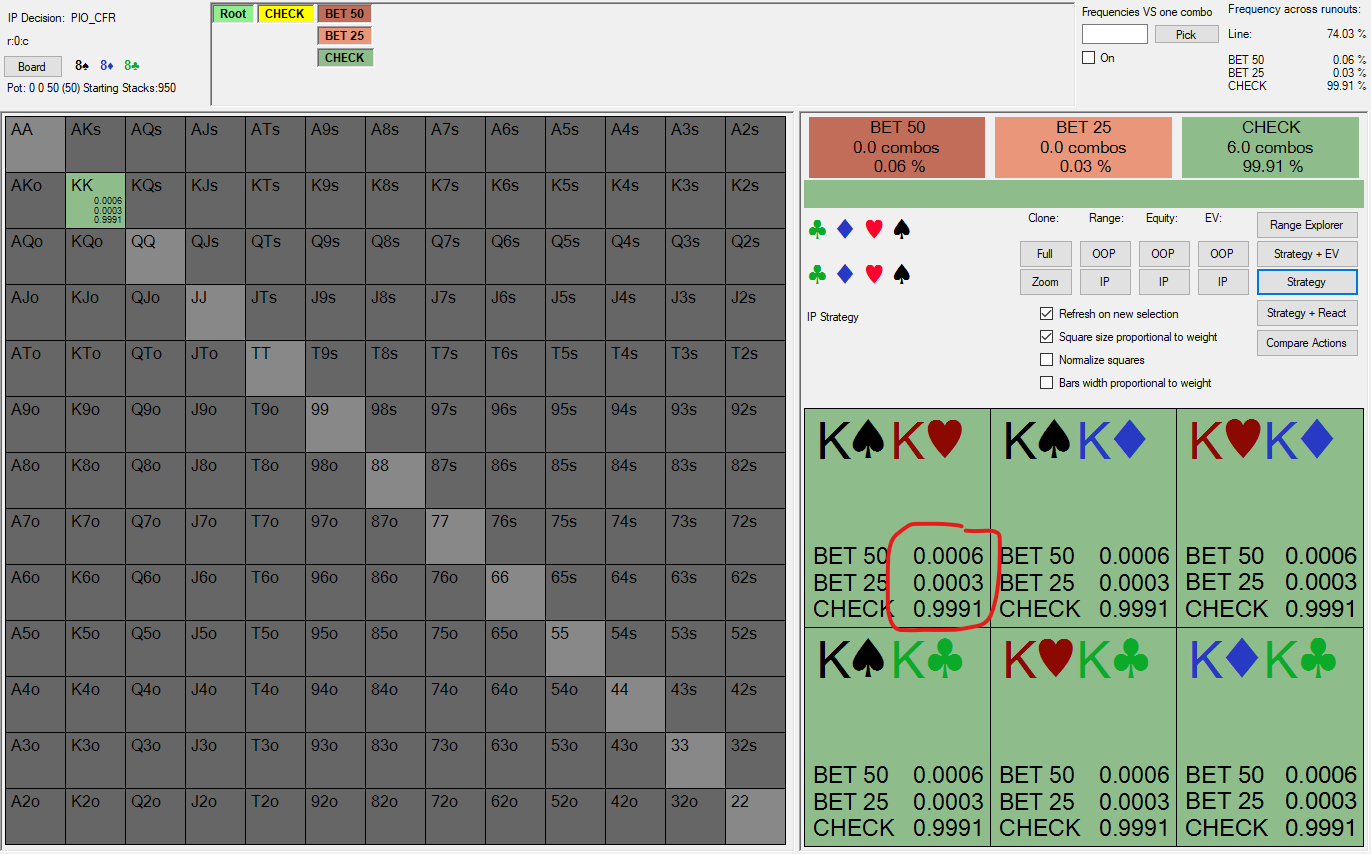
Flop KK strategy when checked to
Why do we use a bigger sizing on the flop? As opposed to the smaller sizing?
We are never using a smaller sizing. The reason for this is that by using a larger sizing on the flop (and also on the turn and river), the OOP player can maximize its bluff to value ratio, since larger bets allow for more bluffs, and increase the number of hands with which it bets with a perfectly polarized range, making the opponent indifferent to calling or folding. Recall that when you do this, you effectively win the pot - if your opponent is indifferent to calling or folding, it means their EV is the same as folding which is just 0.
Why do we mix KK as a call or fold?
This is something I discuss at the end of the blog post. Theoretically, it means that KK is indifferent to calling or folding here and the two options have an equal EV. That being said, KK has to attempt to bluffcatch while at the same time folding sometimes (completely randomly) to avoid being exploitable.
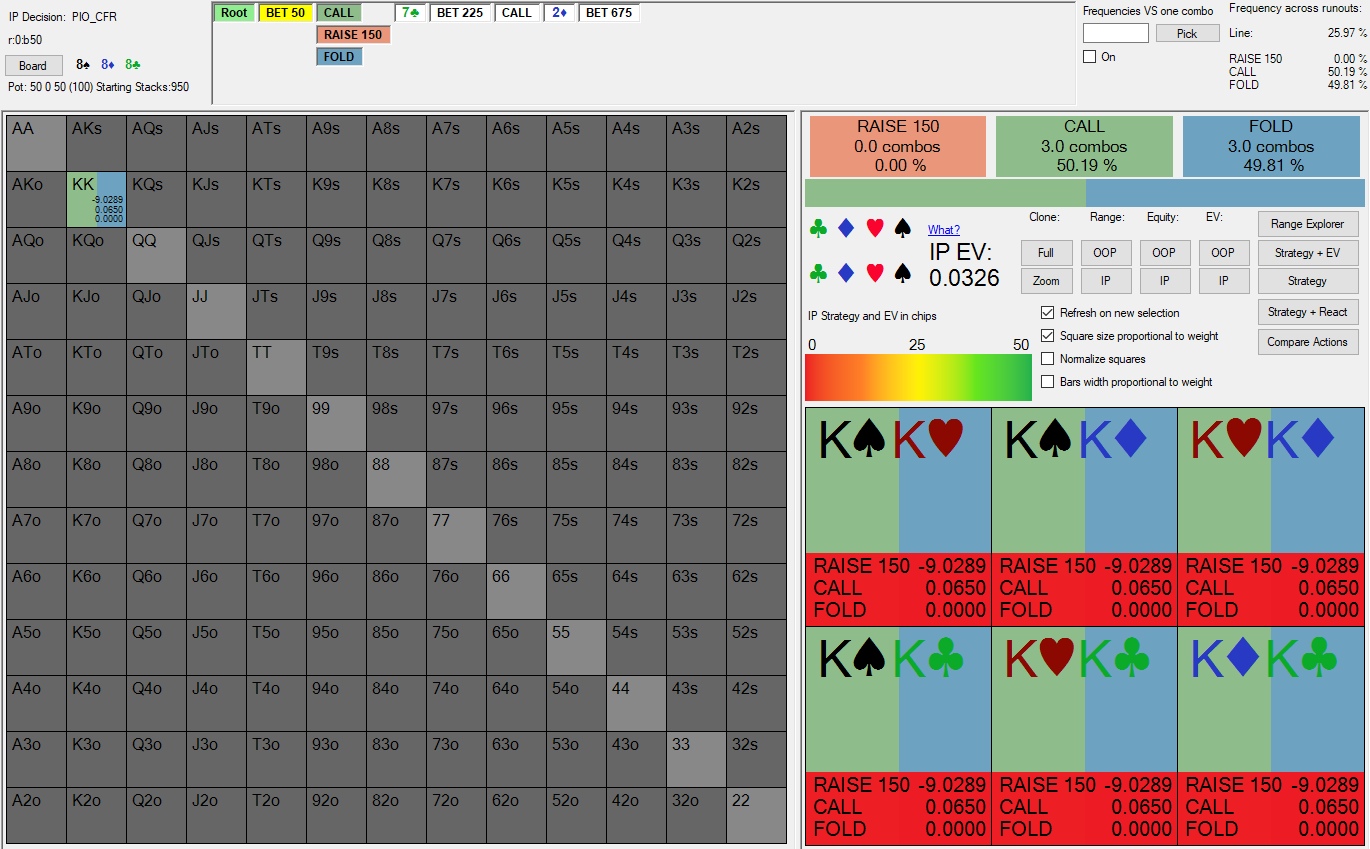
Flop KK EV after OOP bet
Why don’t we check AA at some frequency? No slowplay? No protecting our checking range?
I think the only incentive to slowplay the nuts is to protect our checking range to help it realize its equity. However in this case, our offsuit trash has so little equity (0.6%) that OOP basically gave up on it. You can see that when checked to, KK are actually betting some microscopically small percentage of the time to deny this equity. I’m sure that theoretically, AA would check the flop some even more microscopic percentage of the time to help the offsuit trash realize its equity. However I think PIO’s floating point granularity just doesn’t go that low.
Why don’t KK raise facing a bet on the flop?
When I first asked this question, it just seemed obvious that KK wouldn’t raise against OOP’s range but I couldn’t come up with a simple and intuitive answer why. Then I leveled myself into thinking that the reason KK don’t raise is because OOP can just re-raise with another polarized range. But after running some sims it became clear. It turns out that this question is a very meta-question, and the answer is very useful to understanding theory. Let’s dive in.
Based on my hypothesis that KK don’t raise because OOP can re-raise with another polarized range, I tried running a sim where OOP could only bet once, on the flop, and never raise. Which means if the reason KK don’t raise is because OOP could re-raise, then when we prevent an OOP raise, KK might raise. But KK never ended up raising. Raising was -EV even without OOP re-raising:
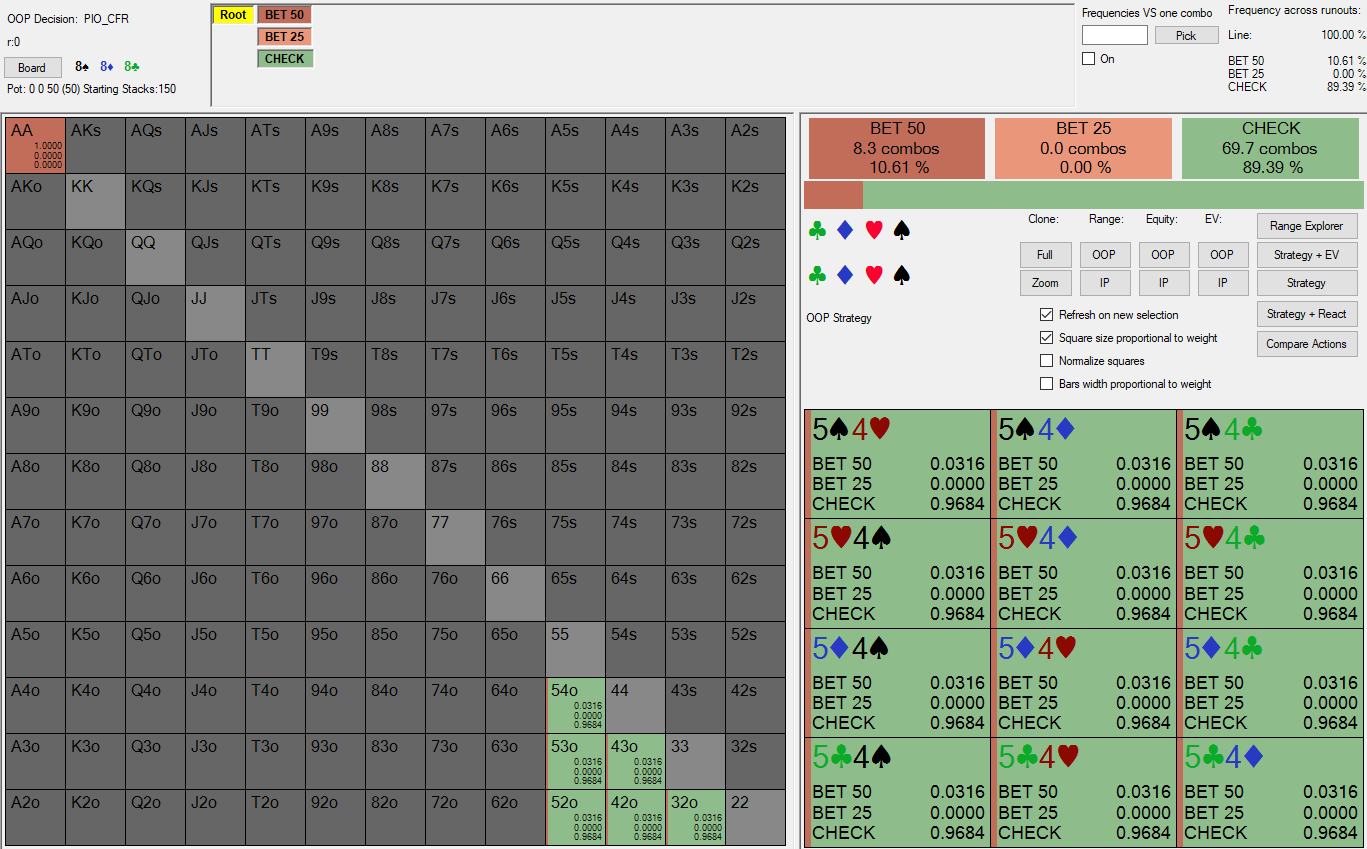
KK raise test 1 - OOP strategy when only one OOP flop bet allowed
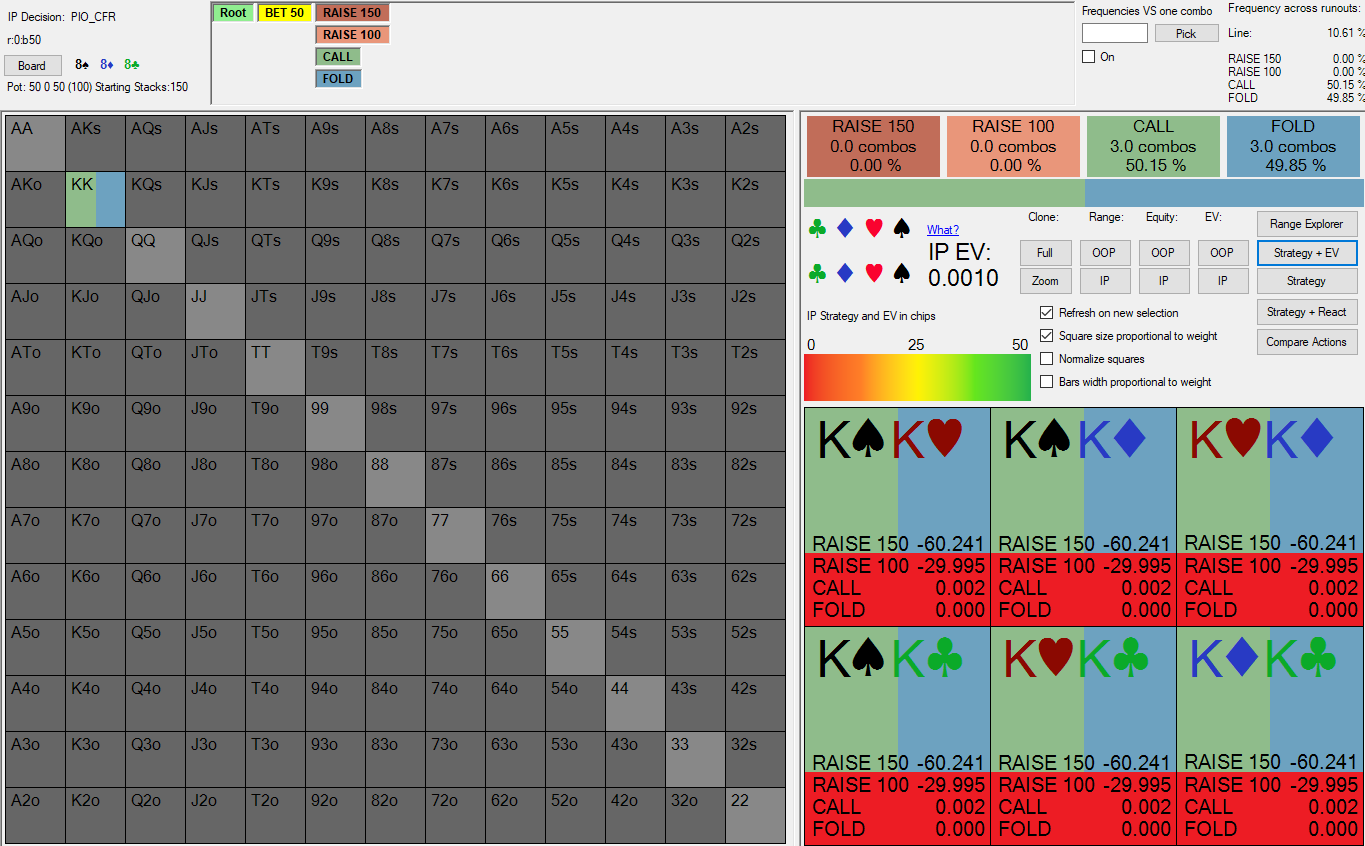
KK raise test 1 - IP strategy when only one OOP flop bet allowed
So clearly its not solely because OOP can re-raise. Then I tried running a sim where I prevented OOP from re-raising, but node locked OOP to always bet its entire range. The goal was to make OOP’s betting range have more bluffs. KK never raised, BUT its EV on a raise went up significantly.
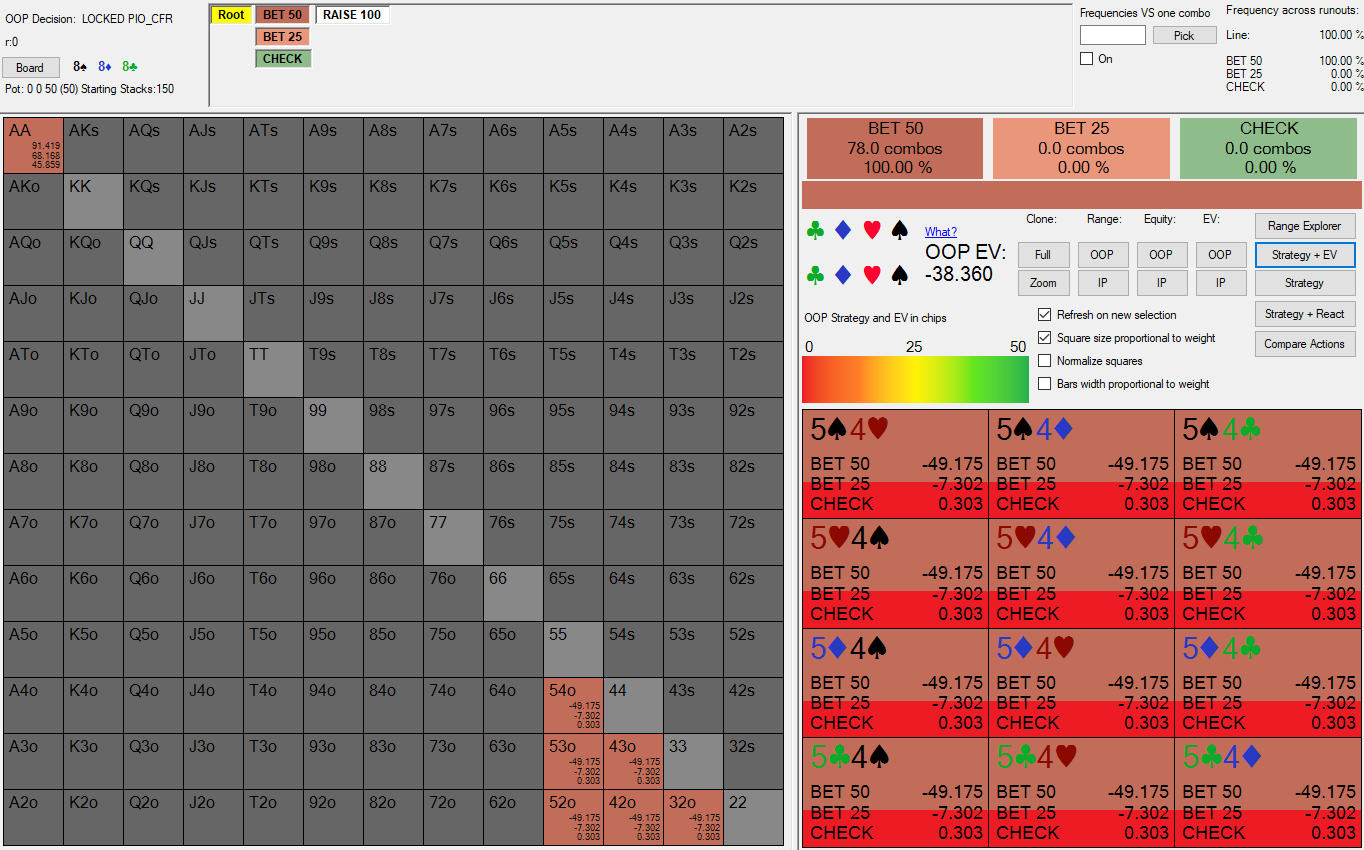
KK raise test 2 - OOP strategy always bet node lock
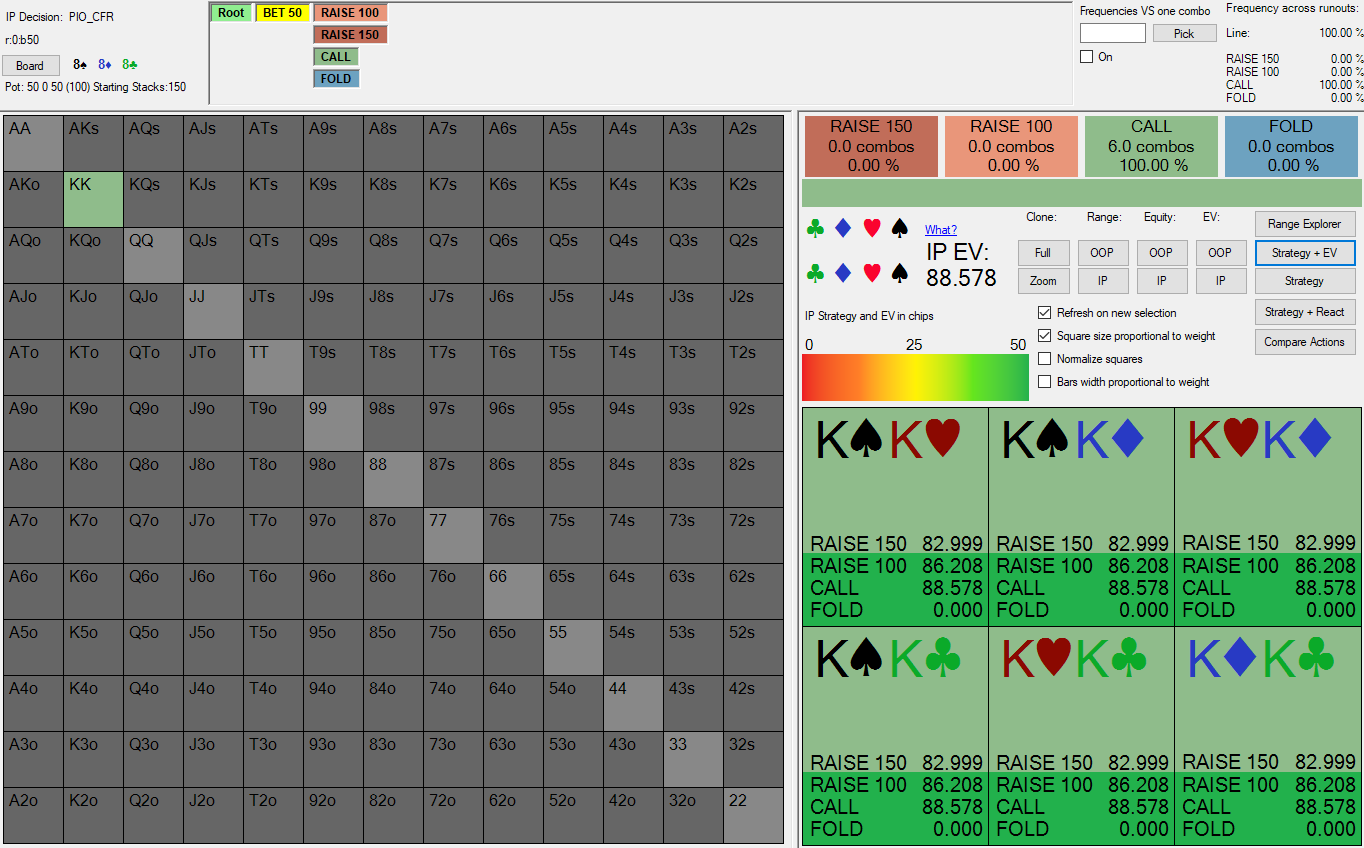
KK raise test 2 - IP strategy when OOP always bet node lock
So I tried running a sim where I added 2 more offsuit trash hands (62o, 63o) to the OOP range and made them always bet. KK still never raised.
I thought this might be because offsuit trash doesn’t have much equity against KK so we might need to add in bluffs with more equity before KK wants to raise. So I added a bunch of suited Ax’s, which have significantly more equity against KK than offsuit trash, and lo and behold, KK raises!:
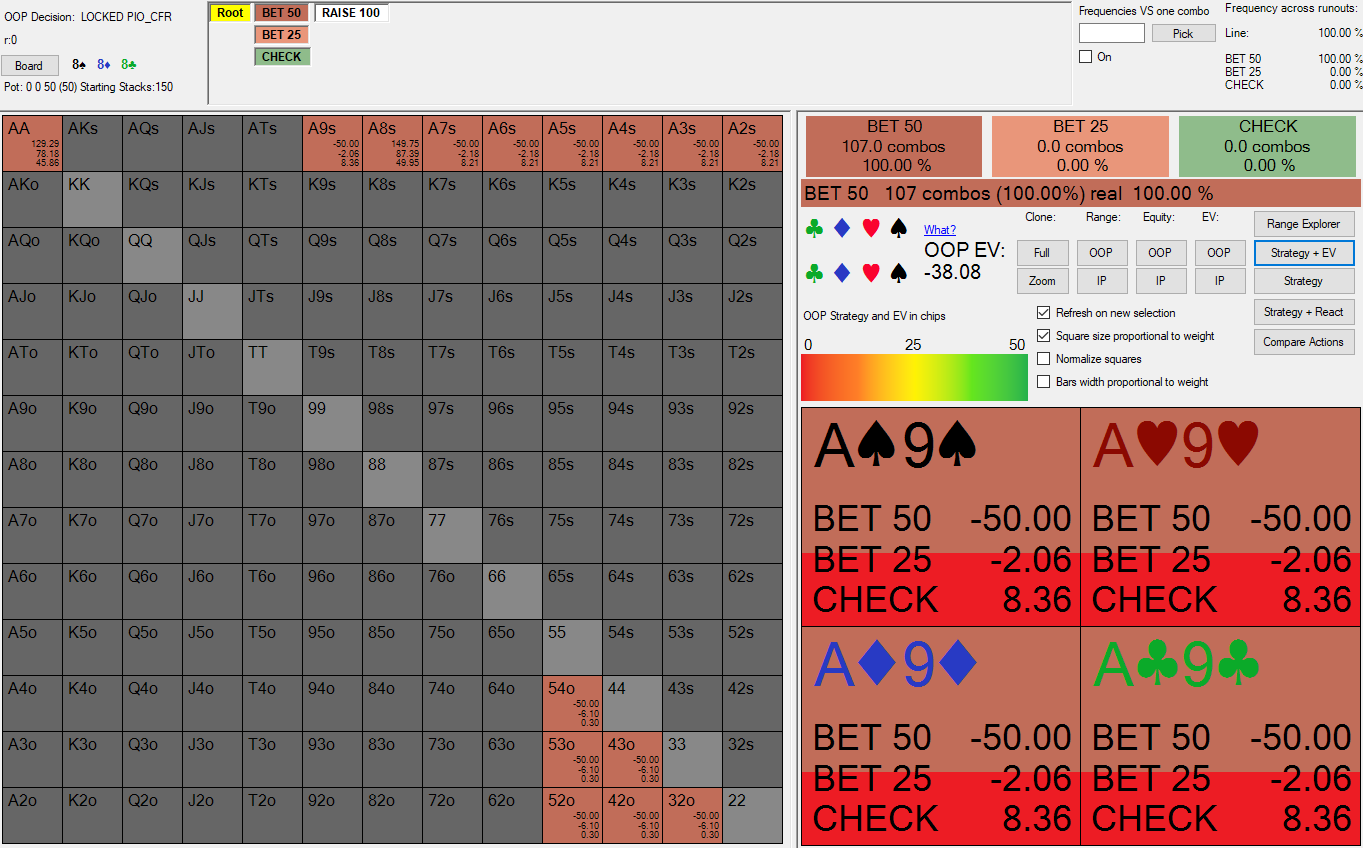
KK raise test 3 - OOP
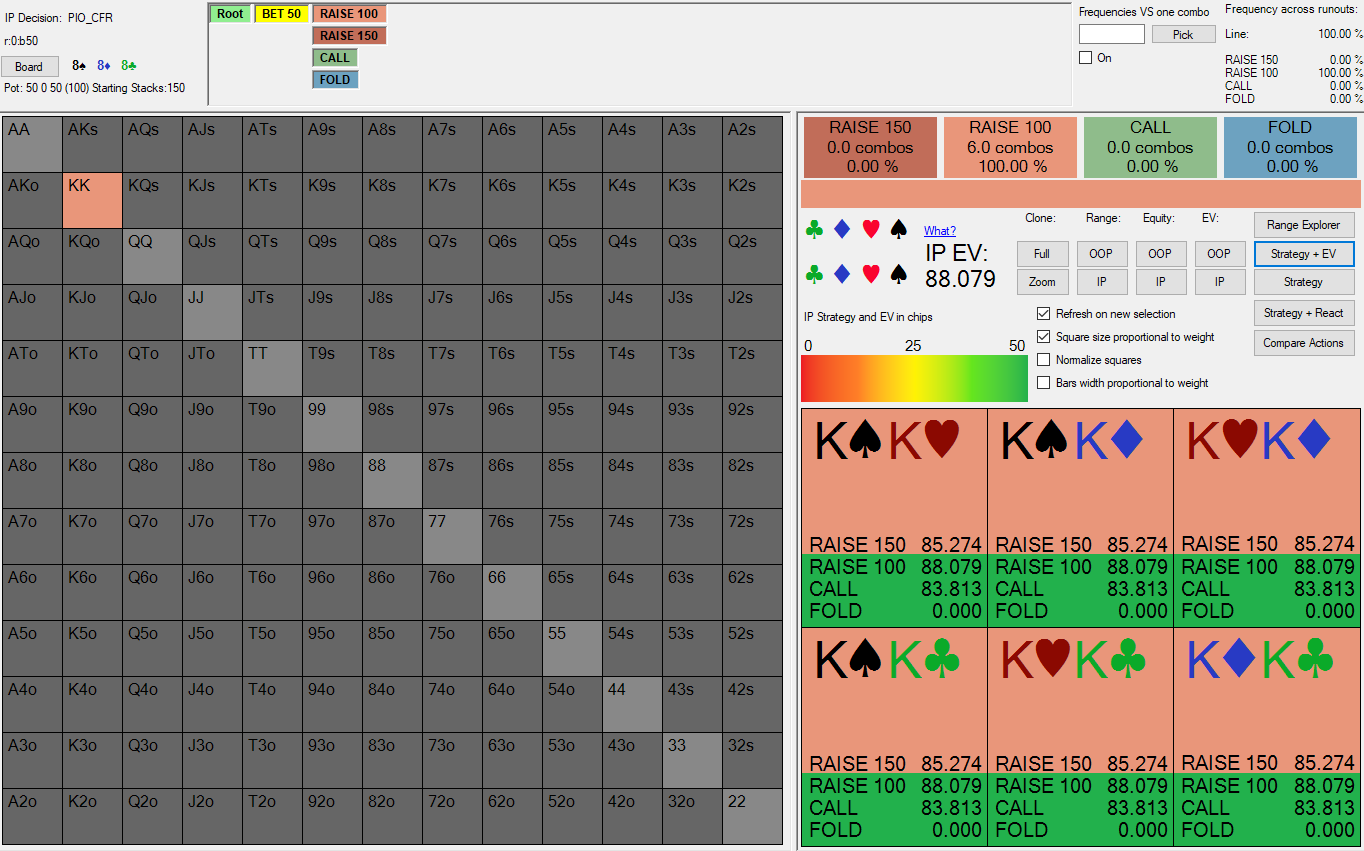
KK raise test 3 - IP facing bet
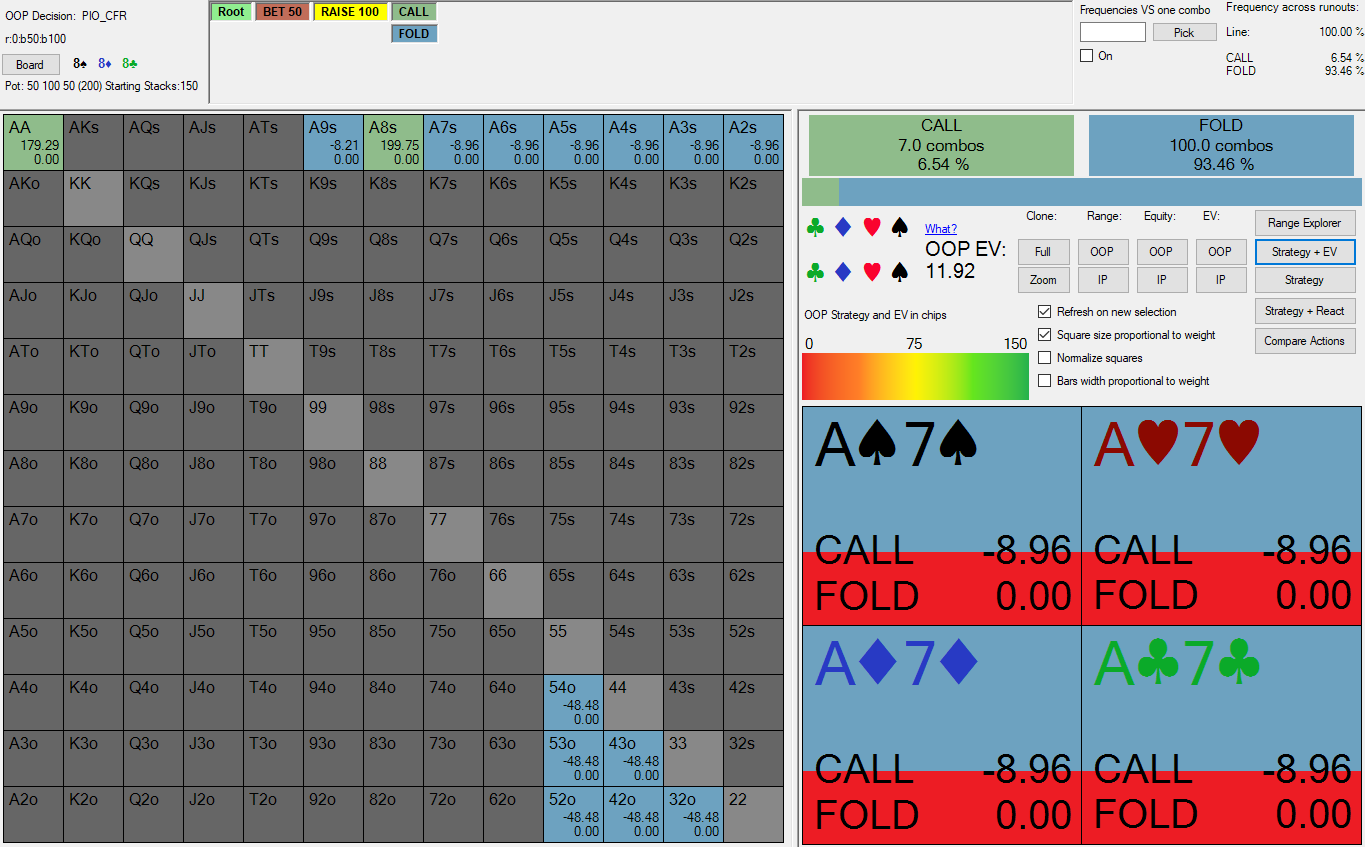
KK raise test 3 - OOP after IP raise
And there you have it, ladies and gentlemen. Whether or not KK raises is about the tradeoff between how much equity it can deny from hands that are behind, and how much it loses when it’s raising into a better hand. And of course, the ratio between how often KK is betting into hands that are behind or ahead.
That being said, OOP’s ability to reraise is also something that affects whether KK want to raise or not. I tried building on top of the previous sim and keeping OOP’s range bet but allowing OOP to raise on the flop (still no betting on turn and river), and KK don’t raise anymore. Which implies that KK are indeed afraid of a re-raise:
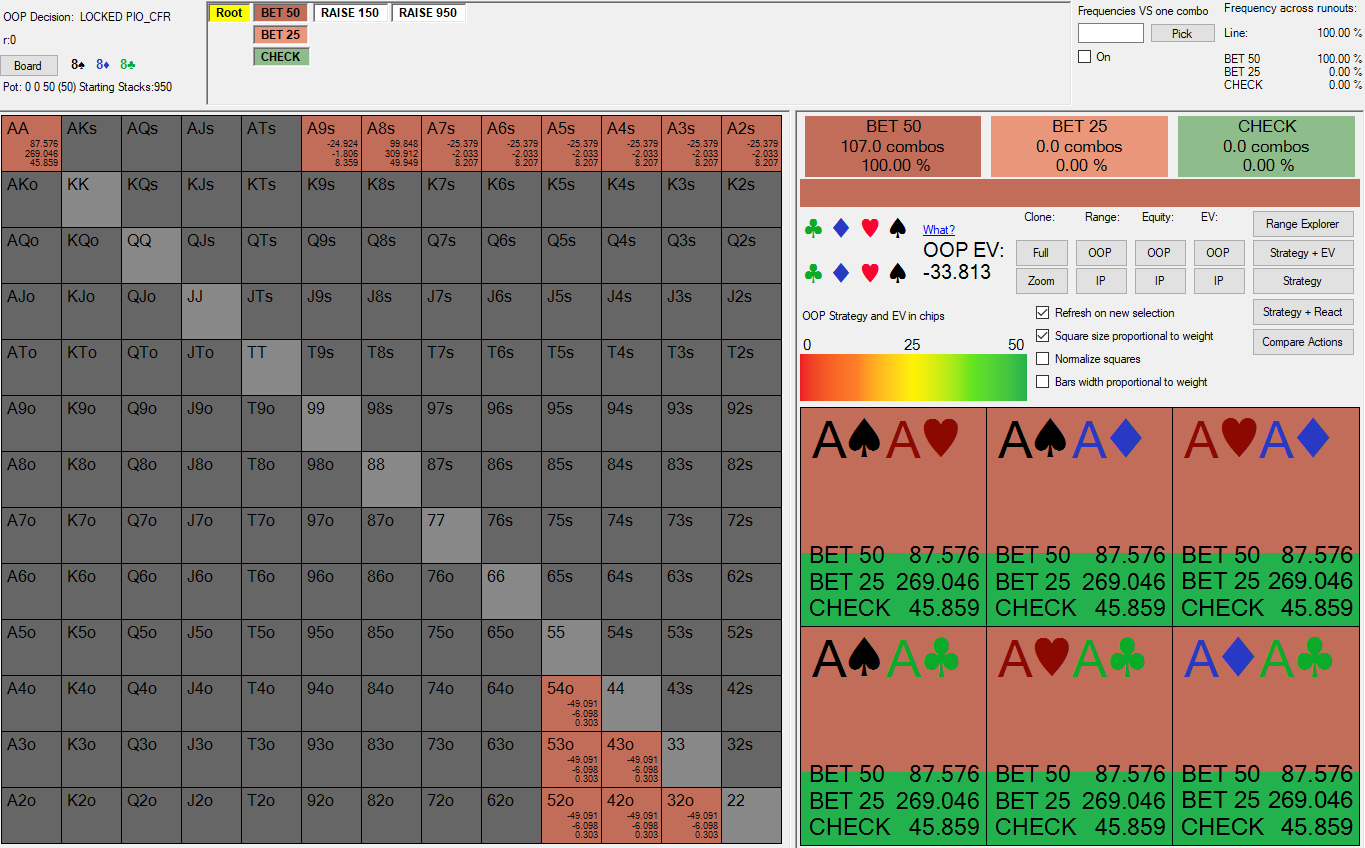
KK raise test 4 - OOP nodelock
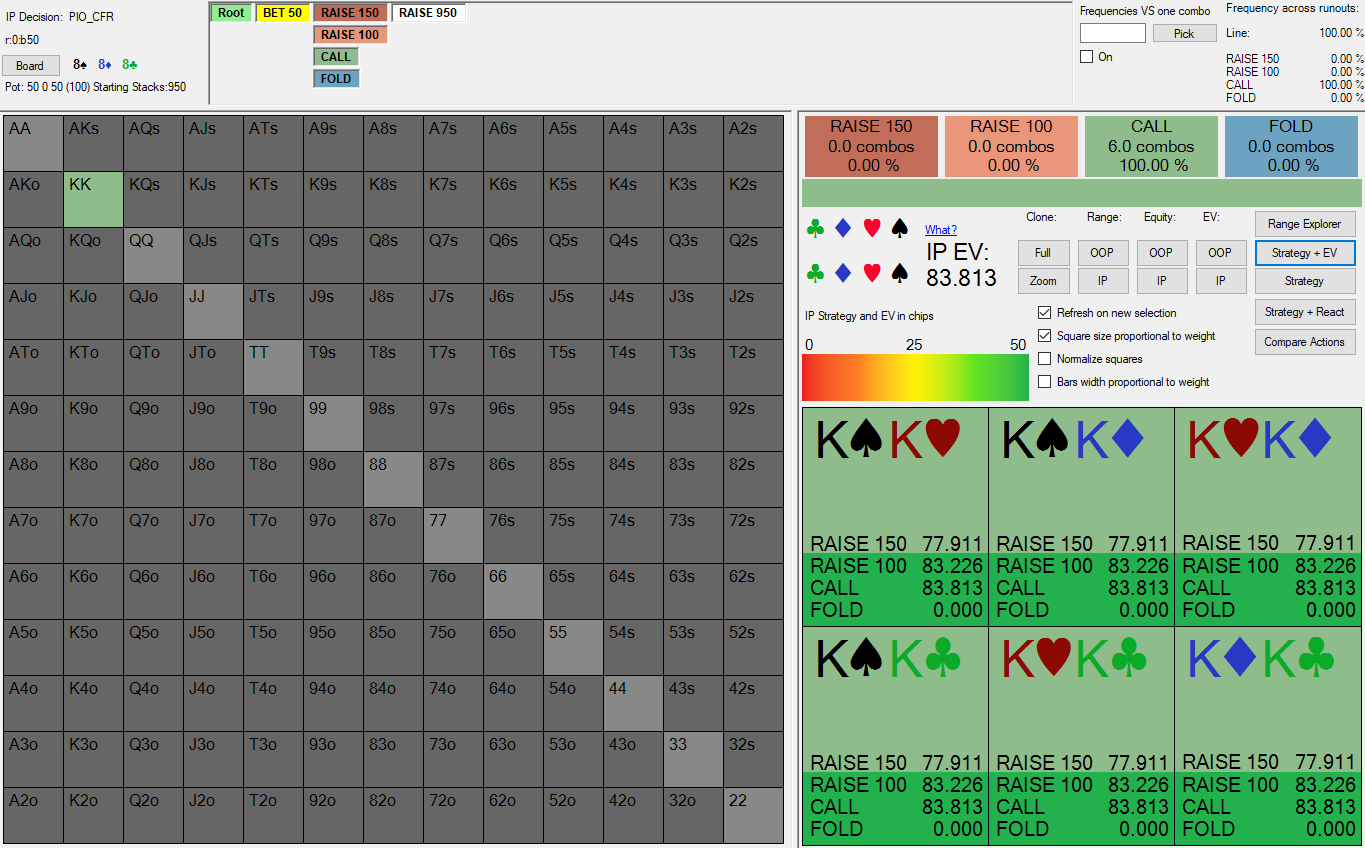
KK raise test 4 - IP
I was curious what KK were so scared of, so I nodelocked KK to re-raise the OOP nodelocked range bet, and this is what the strategy was. Basically, shoving with a balanced range that makes KK indifferent to calling or folding:
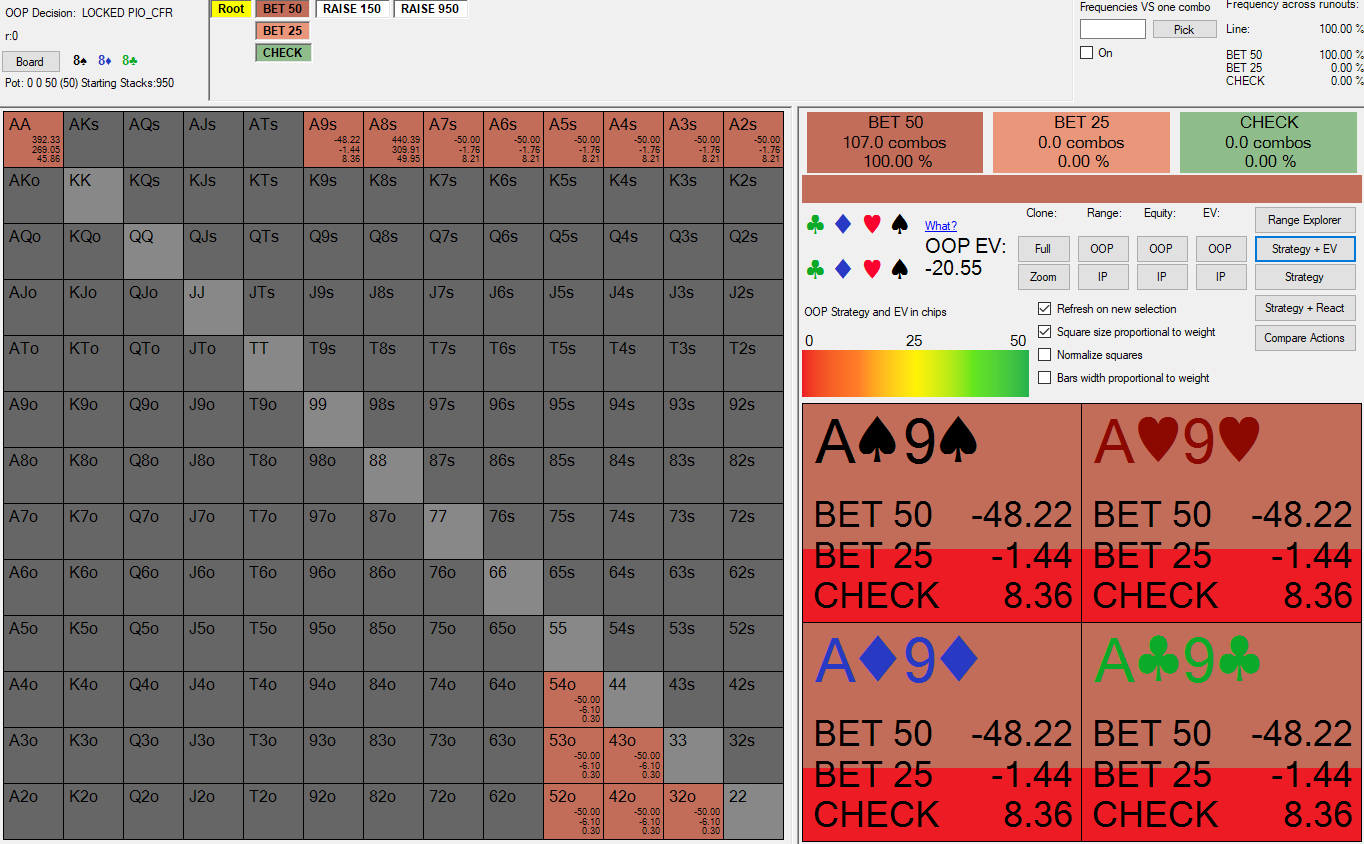
KK raise test 5 - OOP nodelock
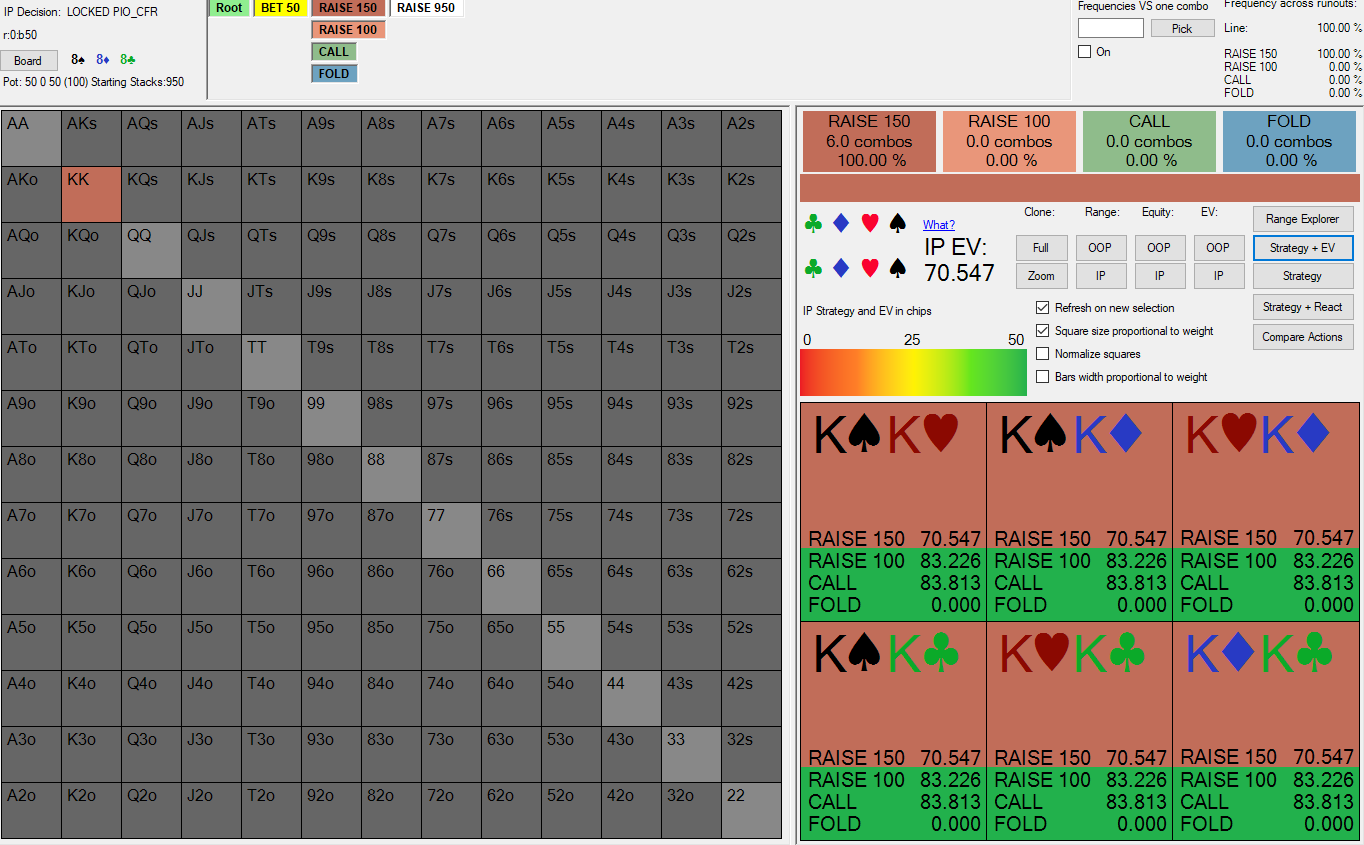
KK raise test 5 - IP nodelock
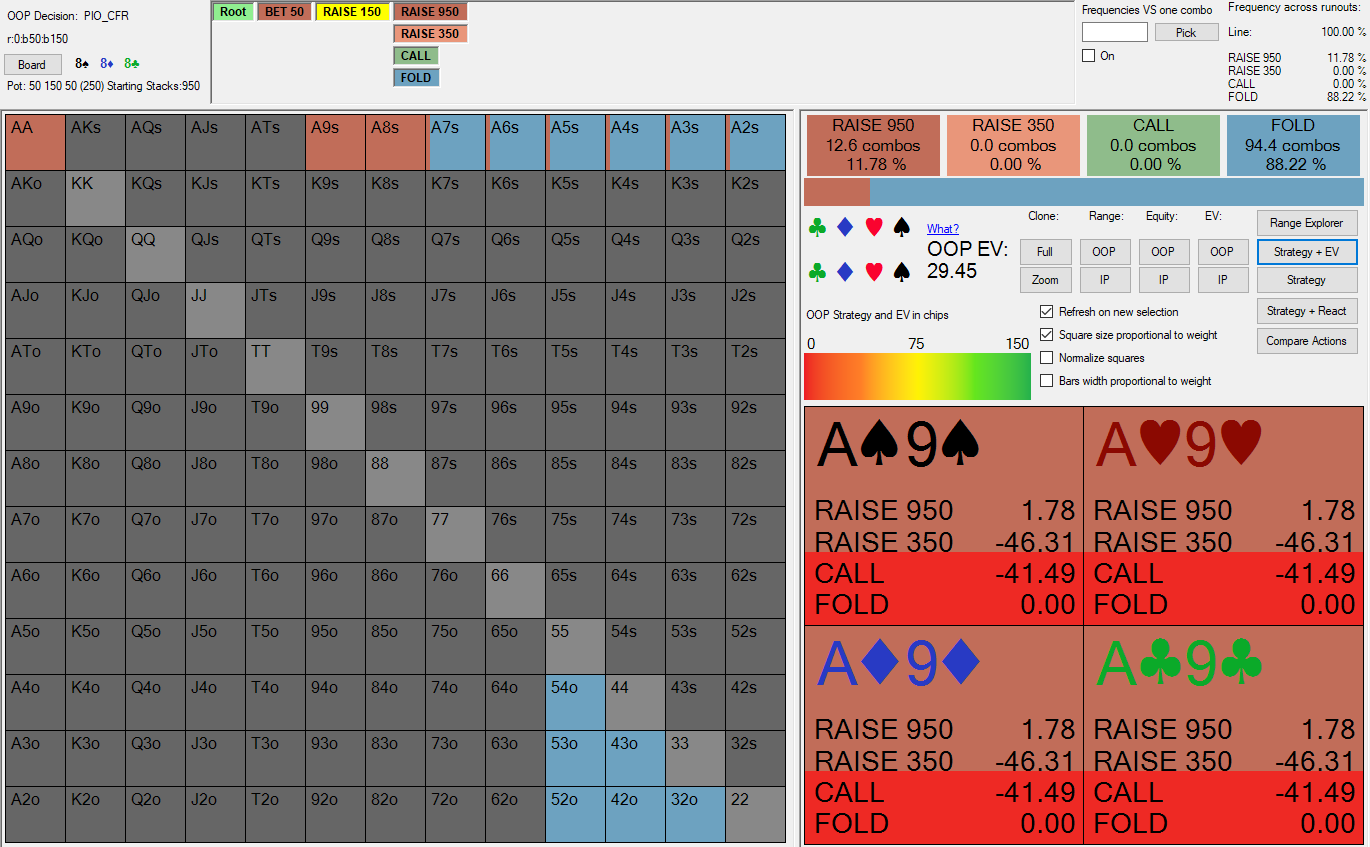
KK raise test 5 - OOP facing raise
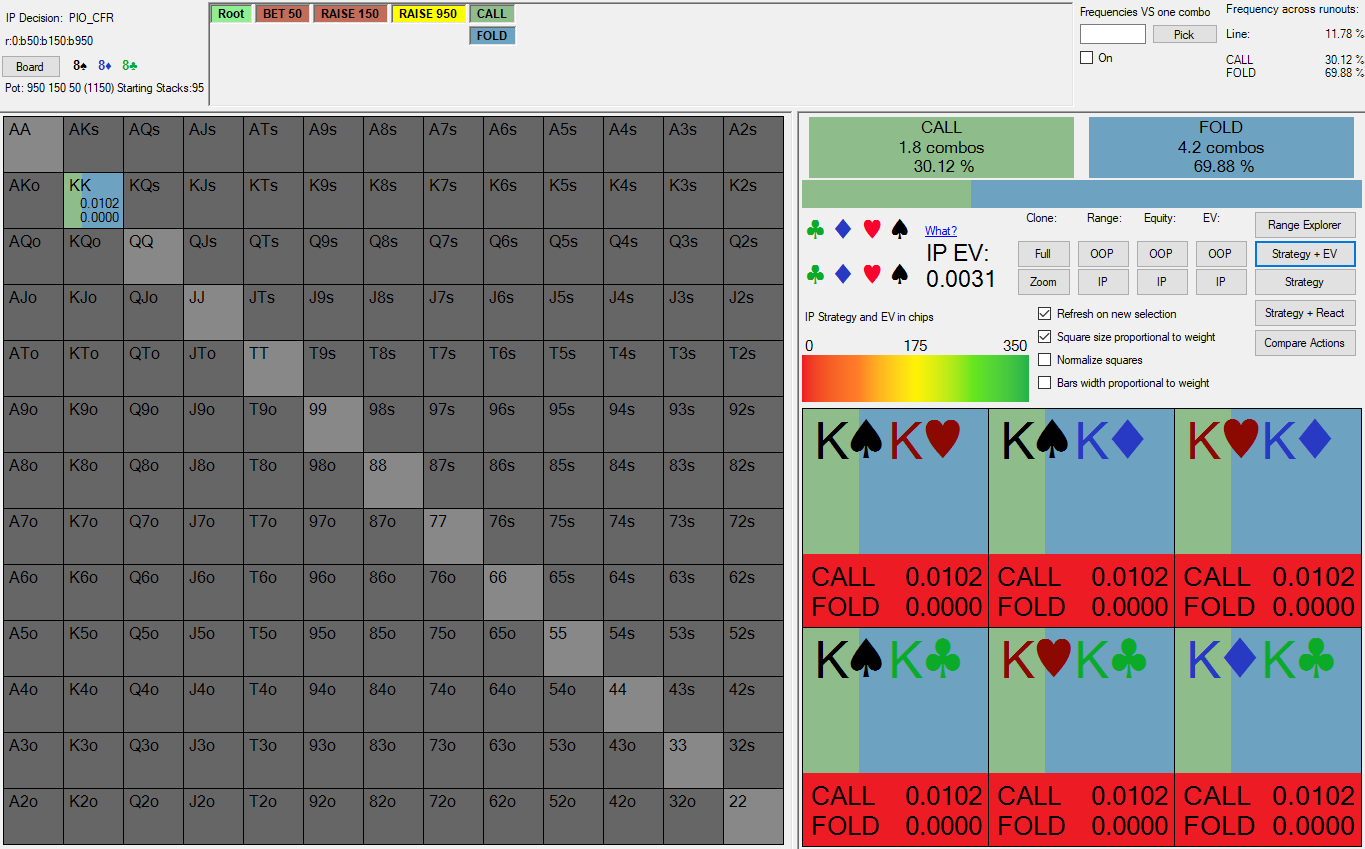
KK raise test 5 - IP facing shove
A fantastic detail about OOP’s shoving range above is that OOP’s bluff preference goes like this, from highest to lowest preference:
- A9s (16.717% equity) (Marginally more equity than other Axs because it wins on a 9 turn and 9 river)
- Axs (16.414% equity)
- Offsuit trash (0.606% equity)
The reason is because by using bluffs with more equity against KK, OOP can add more combos of bluffs into its shoving range, which increases how often it’s winning the pot. Great little detail.
Coming back to why KK doesn’t raise, we can think about it this way. KK never has an incentive to raise (or bet) against a range of pure nuts and pure air. If KK bets against pure nuts, it’s just burning money. If KK bets against a pure bluff, either the bluff will fold (no loss to the bluff because bluffs never win at showdown anyways) or the bluff will re-raise KK as part of a perfectly balanced range, making KK indifferent, and effectively making KK lose the whole pot which is now larger because KK raised.
If we look at things in a vacuum (no ranges involved), a hand with less equity never has an incentive to raise against a hand with more equity. It’s always -EV. On the other hand, a hand with more equity DOES have incentive to raise against a hand with less equity, because if the hand with more equity raises large enough, the hand with less equity won’t be getting the right pot odds to call and can’t make a profitable call (assuming it goes straight to showdown without any more streets of betting). This is what we call “denying equity”.
If we go full circle back to the original sim, we can basically say that there’s enough AA in OOP’s betting range that raising with KK becomes unprofitable. Essentially, the AA are “protecting” the offsuit trash. If OOP’s range consisted of only offsuit trash, KK would always raise and deny equity. But when AA are mixed in there at a high enough frequency, KK simply can’t raise against OOP’s range profitably. That being said, if KK does decide to throw money into the abyss by raising, it’s clear what has to be done based on test sim 5 shown above - re-raise with another perfectly polarized range. And fold all the remaining trash, of course.
I think in general, nutted hands bet together with bluffs to make our opponent’s bluffcatchers indifferent to calling or folding and therefore win the pot. Marginal hands have an incentive to raise if they can deny enough equity that makes it worth it to raise even though they’re sometimes losing money when they’re behind. Obviously, a GTO opponent should construct a betting range with the right ratio of value hands and bluffs, also incorporating the equity of value hands and bluffs, such that it isn’t profitable for a marginal hand to re-raise.
So that’s the theory, but obviously it’s a whole different task to figure out where that boundary is where KK switch from always calling to raising. A task for another day!
Why doesn’t OOP just polarize with an all-in on the flop? Why the shenanigans over turns and rivers?
While thinking about KK raising OOP and potentially getting stacks in on the flop, I got curious about this question. Would OOP prefer to just shove with a balanced range on the flop, instead of betting small and opening itself to raises and having to play turns and rivers?
So I tried running a version of the sim with an additional bet sizing of all-in for OOP on the flop. I guessed that given the option, the solver would opt to shove the flop instead of betting across multiple streets. But, the solver chose never to use the all-in sizing, keeping the same 1x pot sizing. I’m pretty sure the reason is because:
-
If OOP all-ins on the flop, they can basically only have 50% bluffs.
In this case, with a 950 all-in, IP needs to be good
950 / (950 + 950 + 50) = 48%of the time, so OOP can only have 48% bluffs. The amount of bluffs you can have asymptotically approaches 50% (from the bottom) as the bet increases relative to the pot size.

Alpha Value vs Bet Size wrt Pot
- If you instead have multiple streets of betting, you can geometrically increase the amount of bluffs you can have, increasing the number of hands you can add in your perfectly polarized betting ranges, which increases your winnings, because whenever you bet with a balanced range, you effectively win all the money in the pot.
Flop Nuts-To-Bluff Ratio in OOP’s Polarized Betting Range
Okay. So how do we reason about the correct ratio between value and bluffs? How do we know how many bluffs to add in? Fundamentally, the correct ratio of value to bluffs is determined by the bet sizings it takes to get all-in on the river, and the equity our value hands have against our opponent’s range of bluffcatchers. Obviously this is a toy game which is why we can simplify the math like this.
If we look forward to the turn and river, we can see that after betting 1x pot on the flop, OOP wants to bet 1.5x pot on the turn and 1.125x pot on the river to be going all-in on the river with a balanced range. Based on the following alpha values for those bet sizings:
- 1x pot bet should have 0.67 value
- 1.5x pot bet should have 0.625 value
- 1.125x pot bet should have 0.65 value
Multiplying all those, we should have 0.272 proportion of nuts (versus air) in our flop betting range.
However KK also has some equity against AA, and our bluffs have some (0.6%) equity against KK. We aren’t playing with pure nuts and bluffs.
Factoring this additional information in, if we use the equation
nut_equity(nut_ratio) + bluff_equity(1 - nut_ratio) =
0.272, we solve our updated nut_ratio for 0.292.
If we look at the ratio of AA to air in the flop betting range, we see
that it’s 6/20.3 = 0.296:
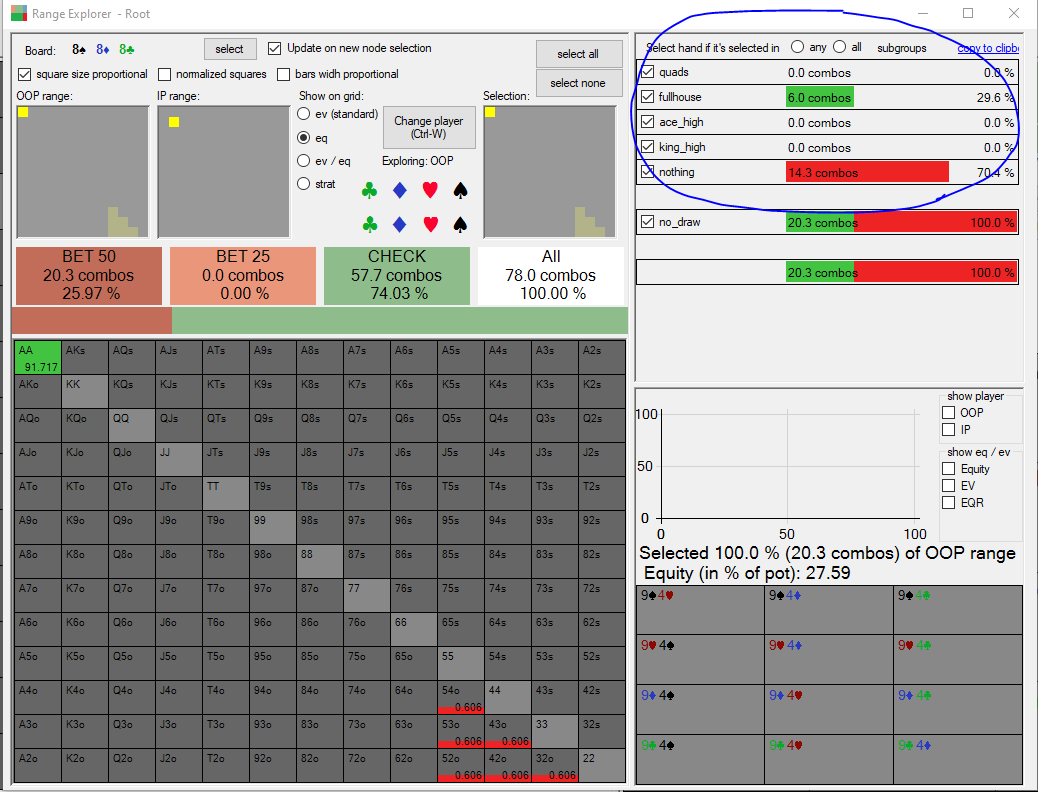
Flop OOP Nut To Bluff Ratio for Bet
Pretty spot on.
Varying Strategy on Turn Runouts
*Thankfully* there isn’t much more to the strategy now. This post is getting kinda long-winded. Here’s the turn strategy and EV OOP:
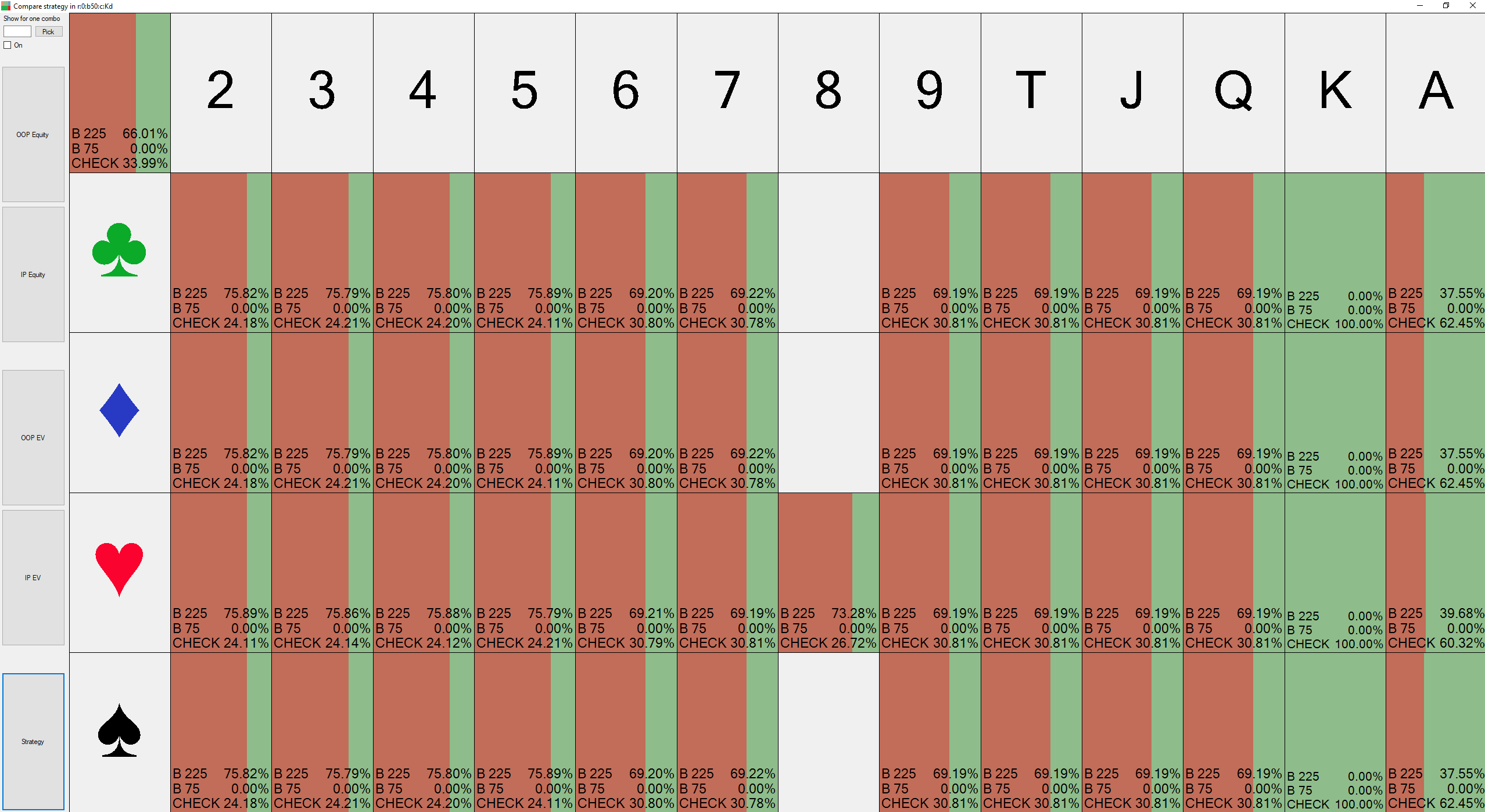
Turn OOP strategy
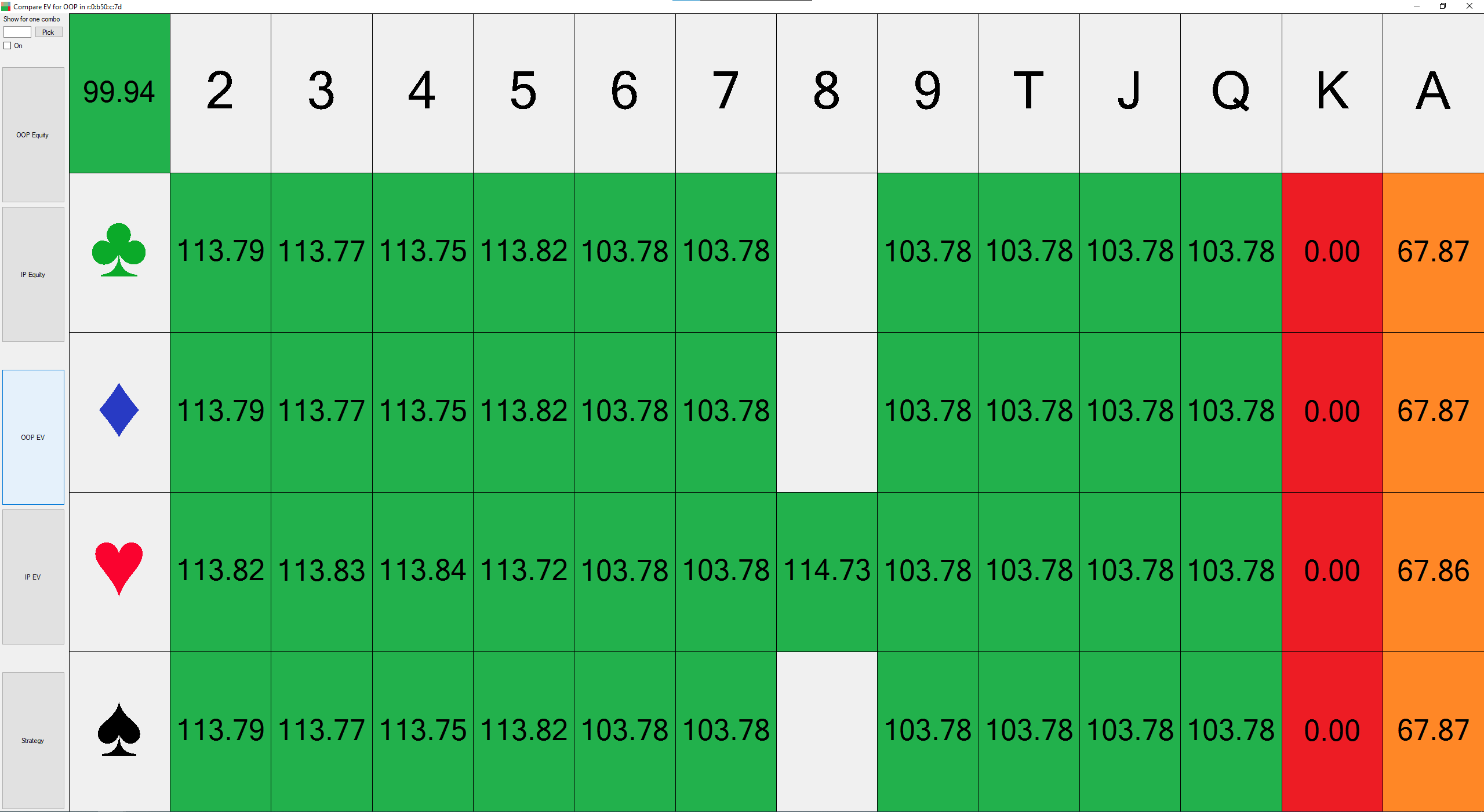
Turn EV OOP
There’s 5 different categories of turn cards:
- A: This is bad for OOP because it reduces the combos of AA we can have. Our betting frequency goes way down. One might naively think it’s good for AA because now KK are drawing dead but the blocker effect is much more important
- K: This is terrible for OOP because now KK can get it in and deny equity. OOP EV is literally 0 here. Check-fold
- 2, 3, 4, 5: These cards are actually good for OOP. The reason is because they block combos of our bluffs, meaning we had AA at a higher frequency than what we wanted on the flop. So we are betting at the highest frequency on these cards
- 8: This card is good for OOP because offsuit trash picks up some equity against KK (chop on K or A) which lets us add slightly more bluff combos
- Anything else: These cards are blanks. OOP continues to bet with a polarized, balanced range
A turn - Why do we check AA at some frequency?
Here’s the OOP and IP strategy on an A turn:
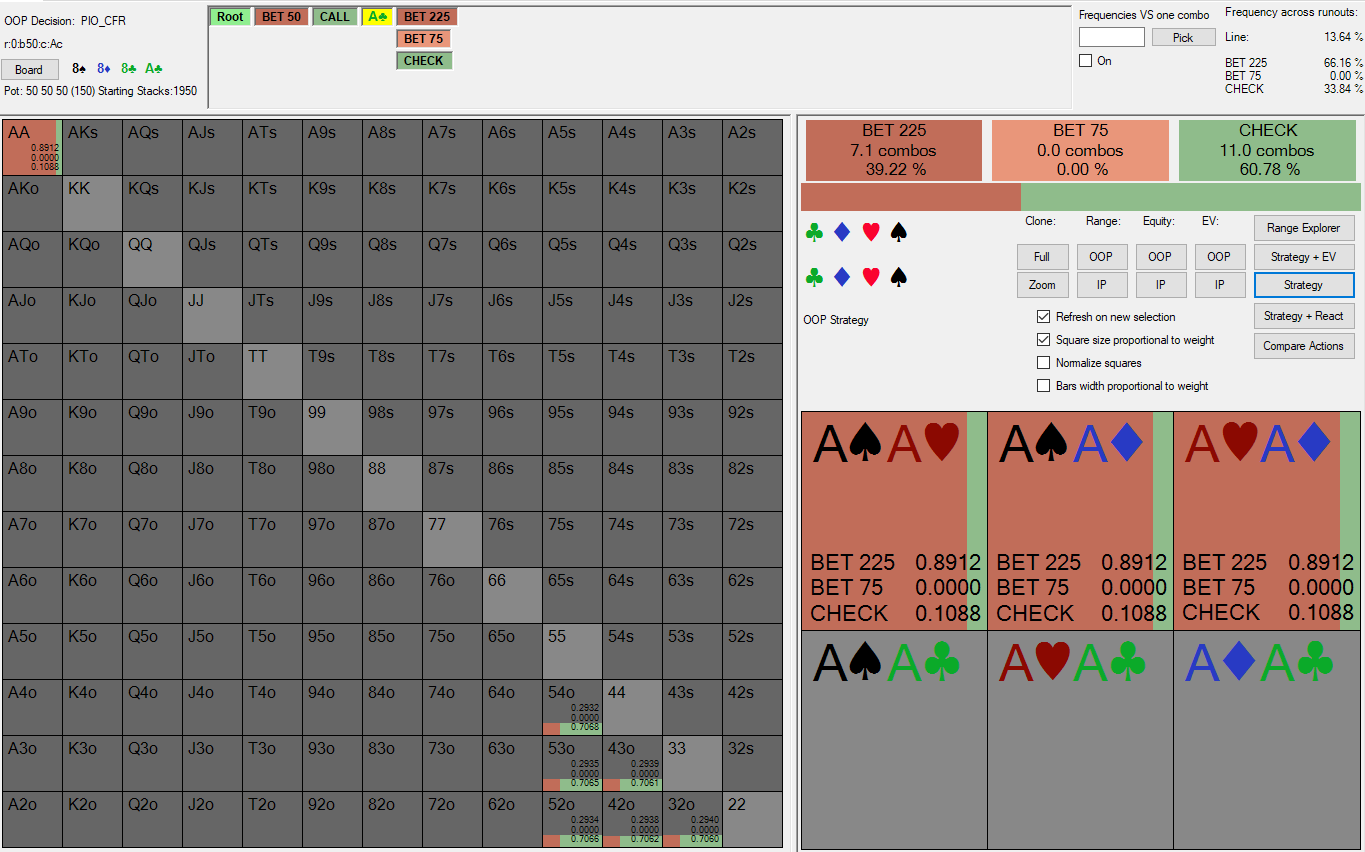
Turn A OOP strategy
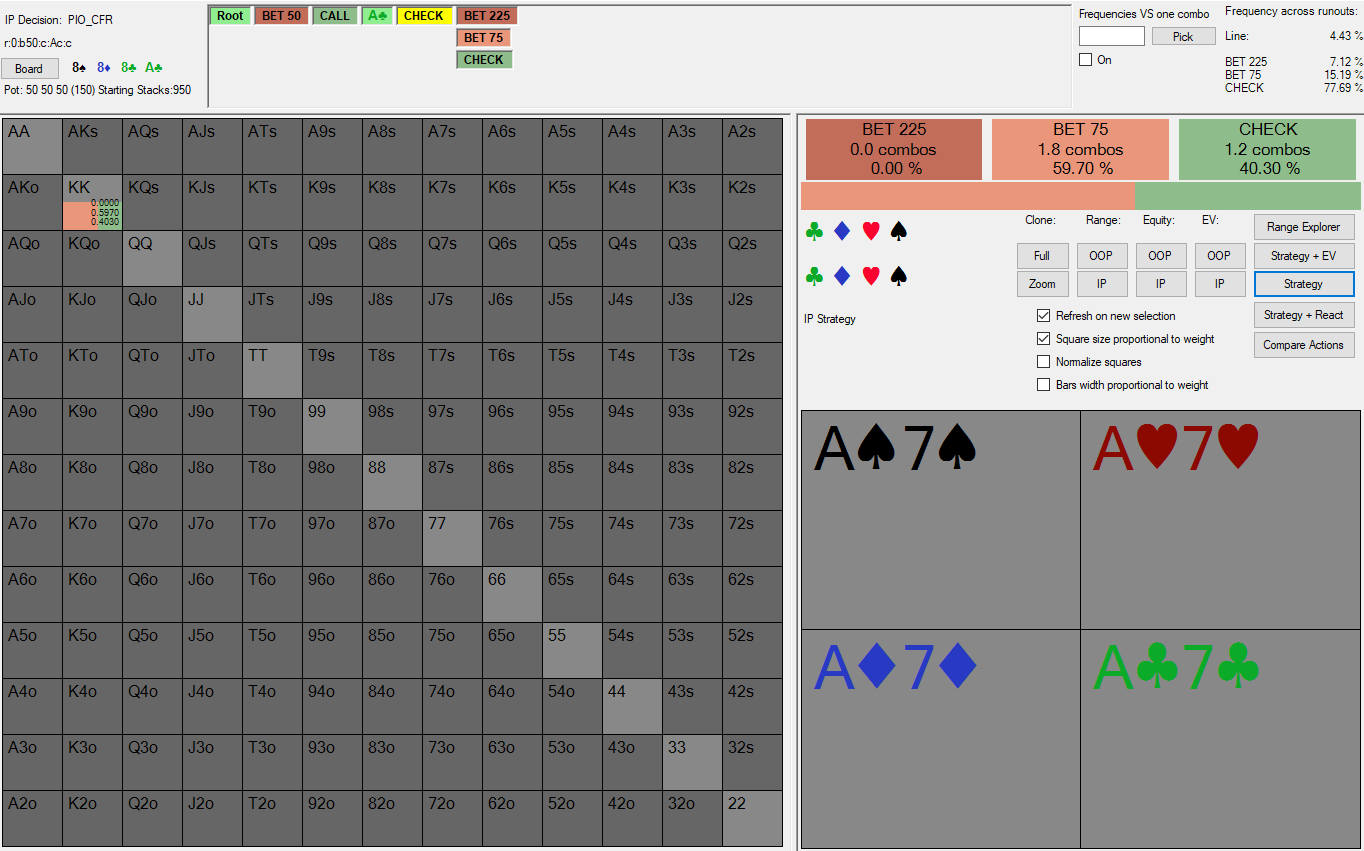
Turn A IP Strategy after OOP check
At first this really confused me. Why do AA check the turn sometimes here if they never check the flop? AA are still always ahead of KK. Additionally, if KK didn’t have any incentive to bet on the flop, why do they bet this turn when checked to sometimes?
The reason is because offsuit trash picks up significant equity (for a chop) against KK on an A turn. Offsuit trash used to have 0.6% equity, now it has 4.5% equity:
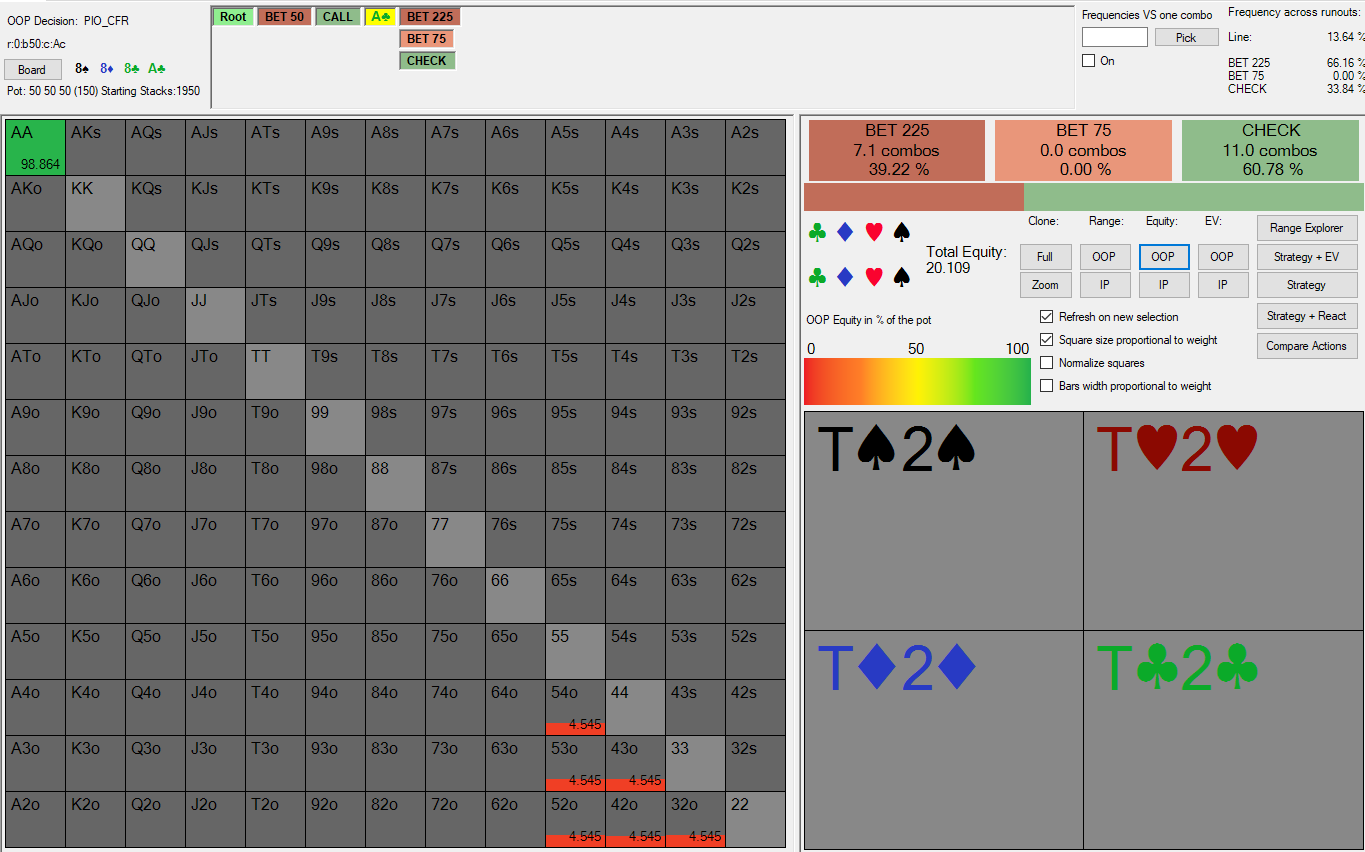
Turn A OOP equity
After an A turn, on an A or 8 river, offsuit trash is chopping against KK. So, KK has an incentive to deny this equity by betting. GTO’s response to this is to slowplay AA at a very low frequency to protect its offsuit trash and help them realize their equity.
I ran a version of the sim where I didn’t give KK the option to bet the turn and then OOP never slowplayed AA. This makes sense because its checking range doesn’t need to be protected; offsuit trash will always be able to realize its equity.
I also ran a version of the sim where I didn’t give OOP the option to bet the river (meaning AA’s only incentive to slowplay is if KK bets the turn after a OOP check) and AA still checks the turn sometimes, just at a lower frequency.
As I already mentioned, on the flop, there is the same incentive for AA to check back at some extremely low frequency to help its offsuit trash realize its equity, but offsuit trash has such low equity on the flop (0.6%) that the checking ratio is so small that PIO can’t detect it.
A turn - number-crunching the bluff ratio
Obviously the other elephant in the room is that on an A turn, the combos of nuts we can have is halved, which reduces the amount of bluffs we can add to our betting ranges, which reduces our betting overall.
With 1.5x pot on the turn and 1.125x pot on the river, we want 40% value in our betting range if we forget the marginal equity of KK vs AA and offsuit air vs KK. Sure enough, our betting range has 40% value, so its pretty close:
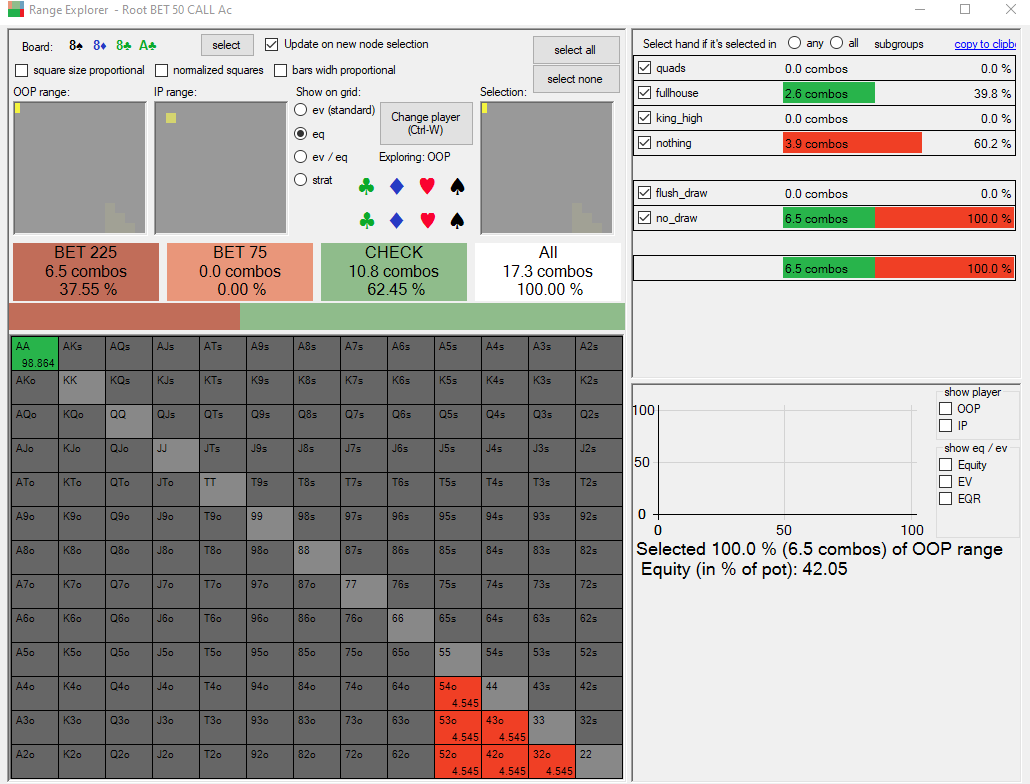
Turn A OOP Betting Range
K turn
A K turn completely wrecks the equity for OOP:
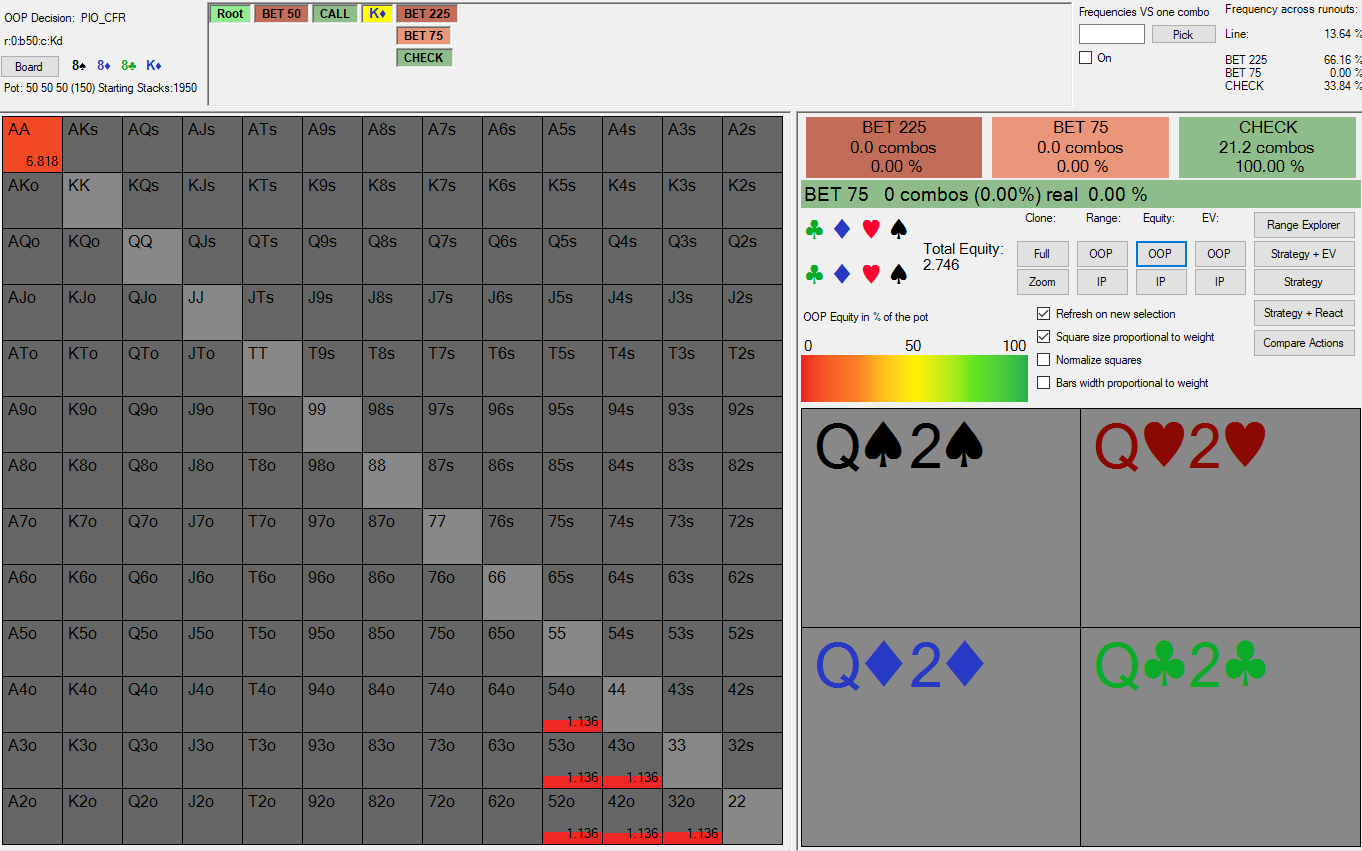
Turn K OOP equity
That being said, OOP still has some marginal equity, but is check-folding its entire range. EV of calling AA is negative. Why is that?
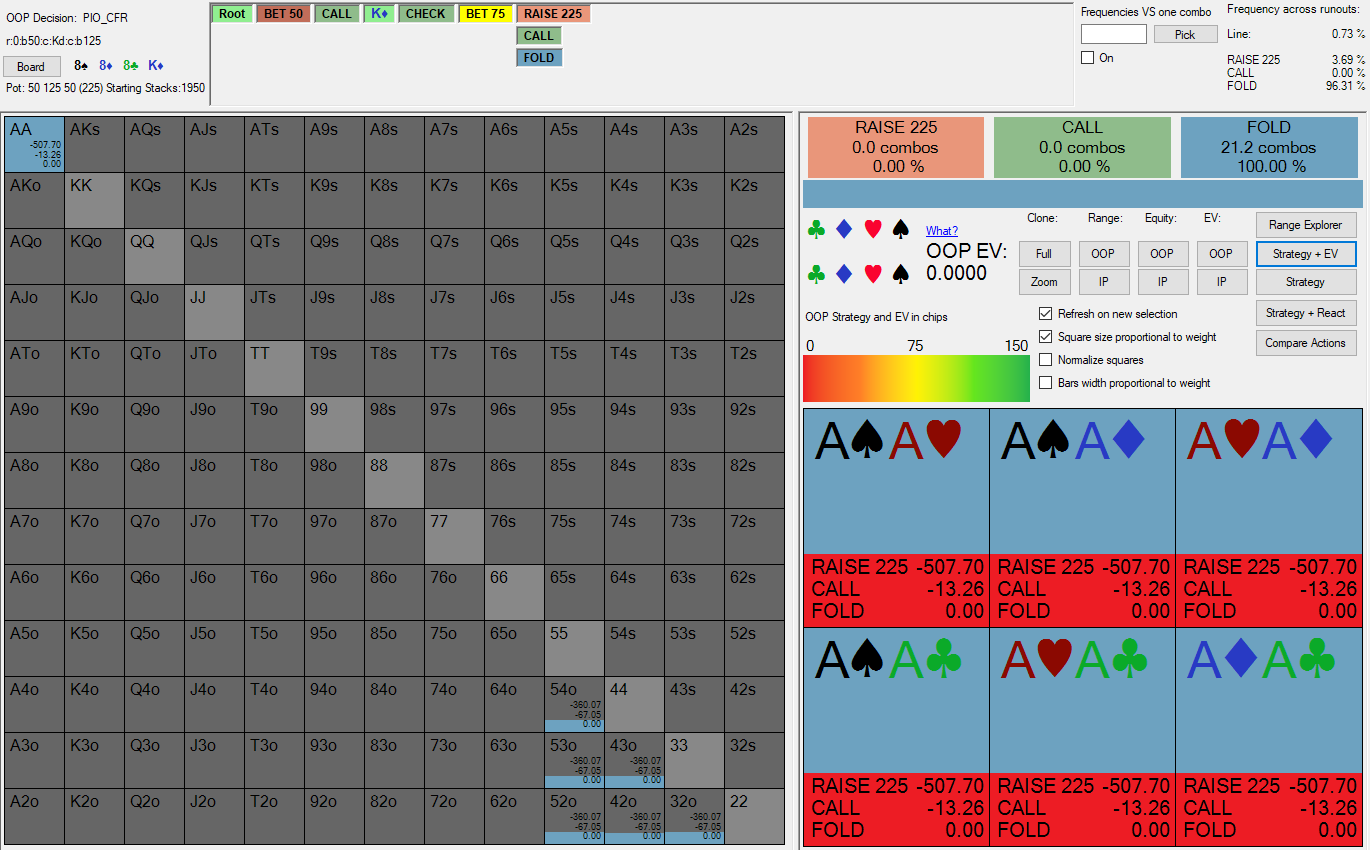
Turn K OOP strategy against bet after checking
The reason is because OOP isn’t getting the right pot odds to call. With equity of 6.8%, without any more streets of betting, AA can only make a breakeven call at ~8% pot-sized bet. Additionally, even if we hit our outs, AA can’t get any value because our range is literally only AA. So there’s 0 implied odds here. KK will just muck on the bad rivers.
I ran a version of the sim where KK can only bet 10% on the turn, and AA can’t call:
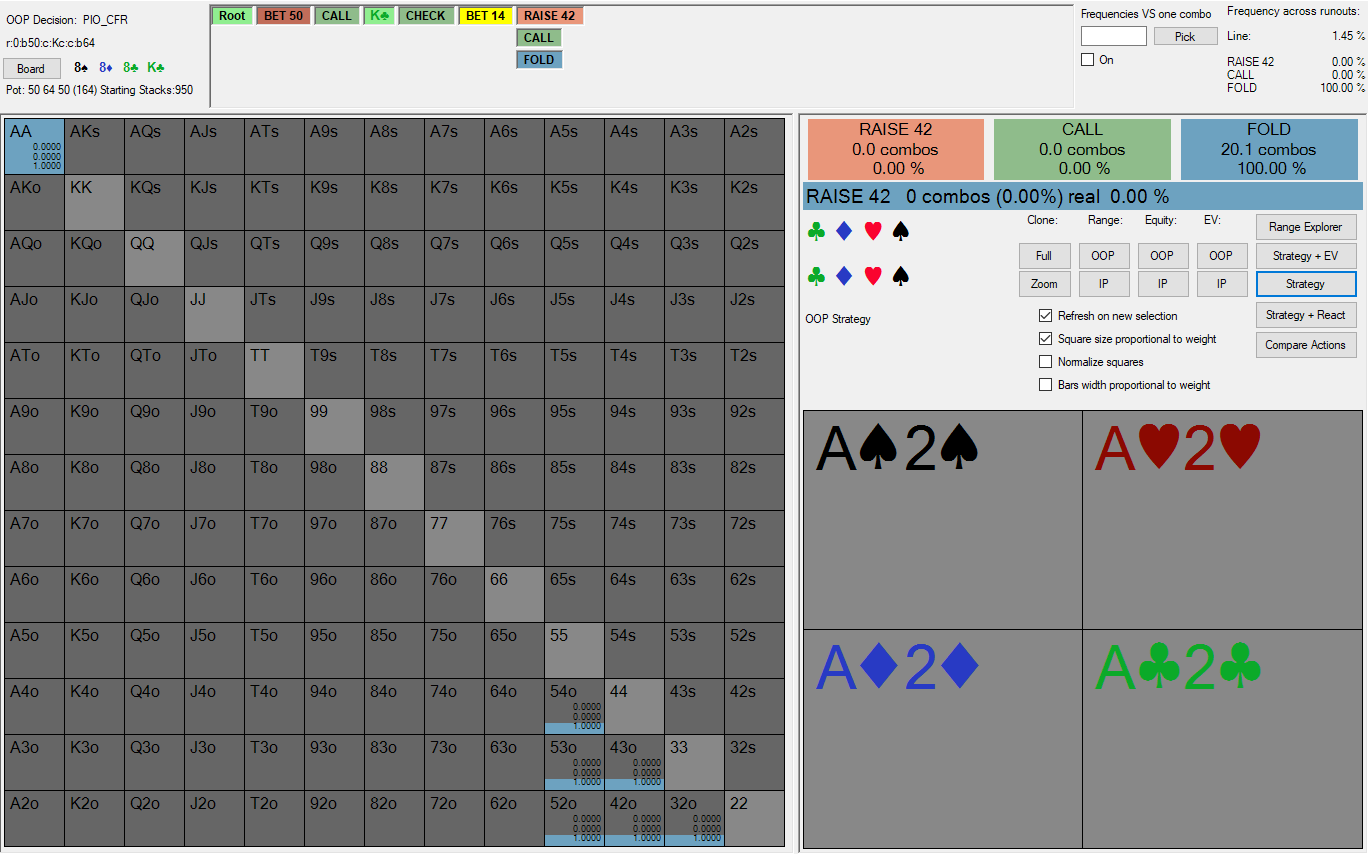
Turn K OOP strategy against 10 percent bet
If we run another sim where KK can only bet some ridiculously small size like 2% of the pot, we see that AA are now calling because they are getting the right pot odds:
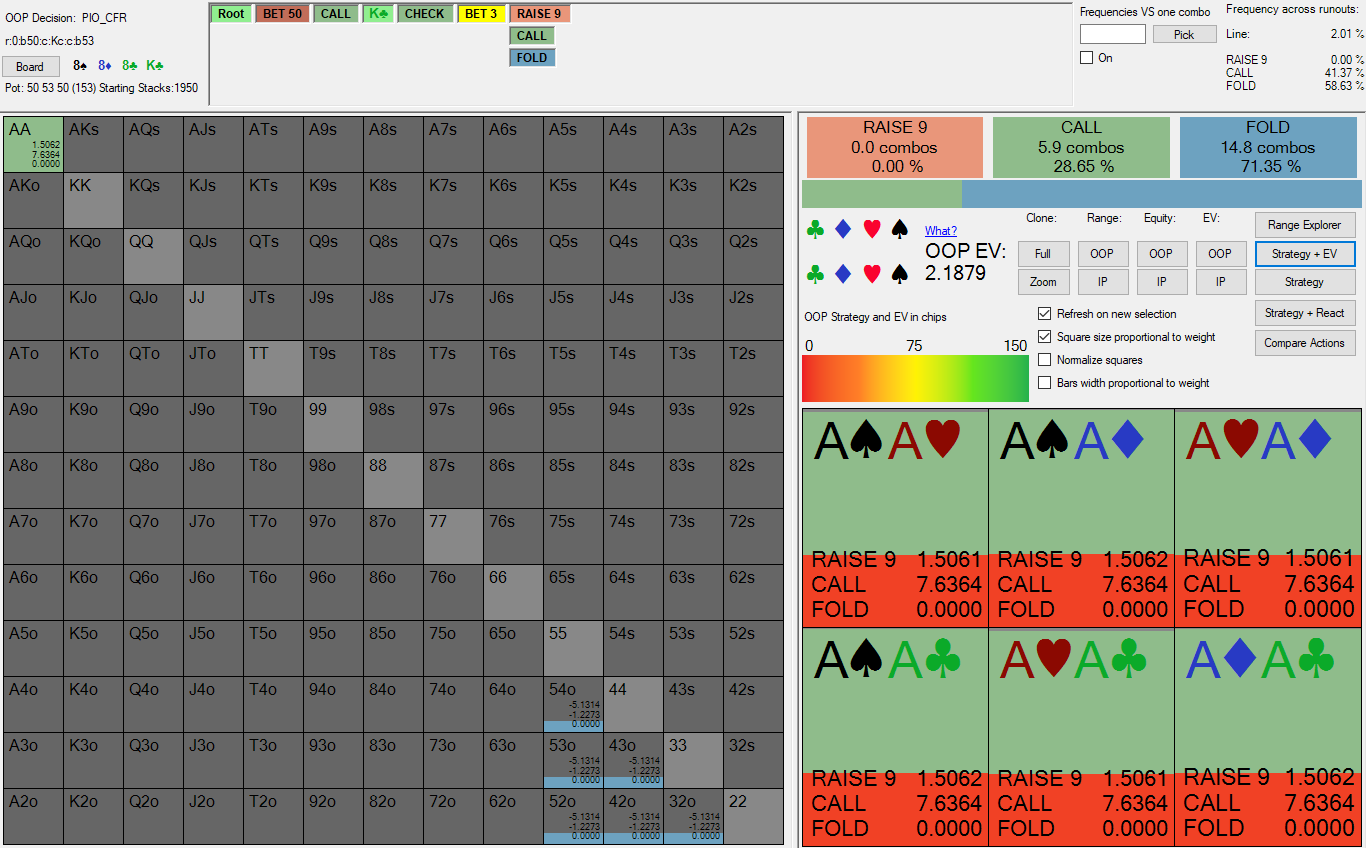
Turn K OOP strategy against 2 percent bet
2, 3, 4, 5 turn
We’re never slowplaying AA here because offsuit trash is drawing dead. The number of AA we have remains the same, and the number of bluffs we bet also remains the same (as on a blank), but the betting range just happens to be a larger percentage of our overall range because these turn cards block some combos of our bluffs.
AA makes up 43% of our betting range here:
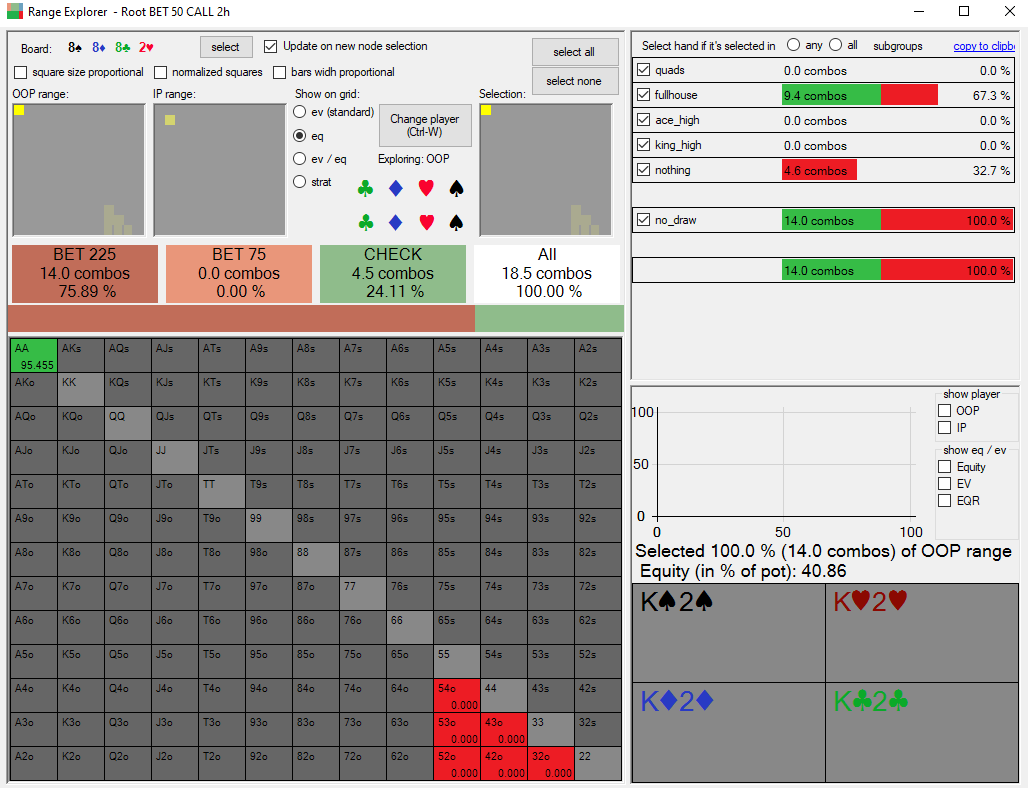
Turn 2 OOP Betting Range
8 turn
Our offsuit trash picks up a lot of equity here - it chops on an A or K river. We slowplay AA a very small portion of the time, to protect our offsuit trash which has some equity. We can have a greater ratio of bluffs in our betting range because our offsuit trash bluffs have a bit more equity against KK. Specifically our betting range has 39% AA now.
8 turn is similar to A turn in that our bluffs pick up some equity and need help to be able to realize that equity.
Similar to the A turn, KK also is mixing between betting and checking once checked to, in order to deny the equity of offsuit trash.
Blank turn
Here’s OOP strategy on a blank turn. Pretty standard:
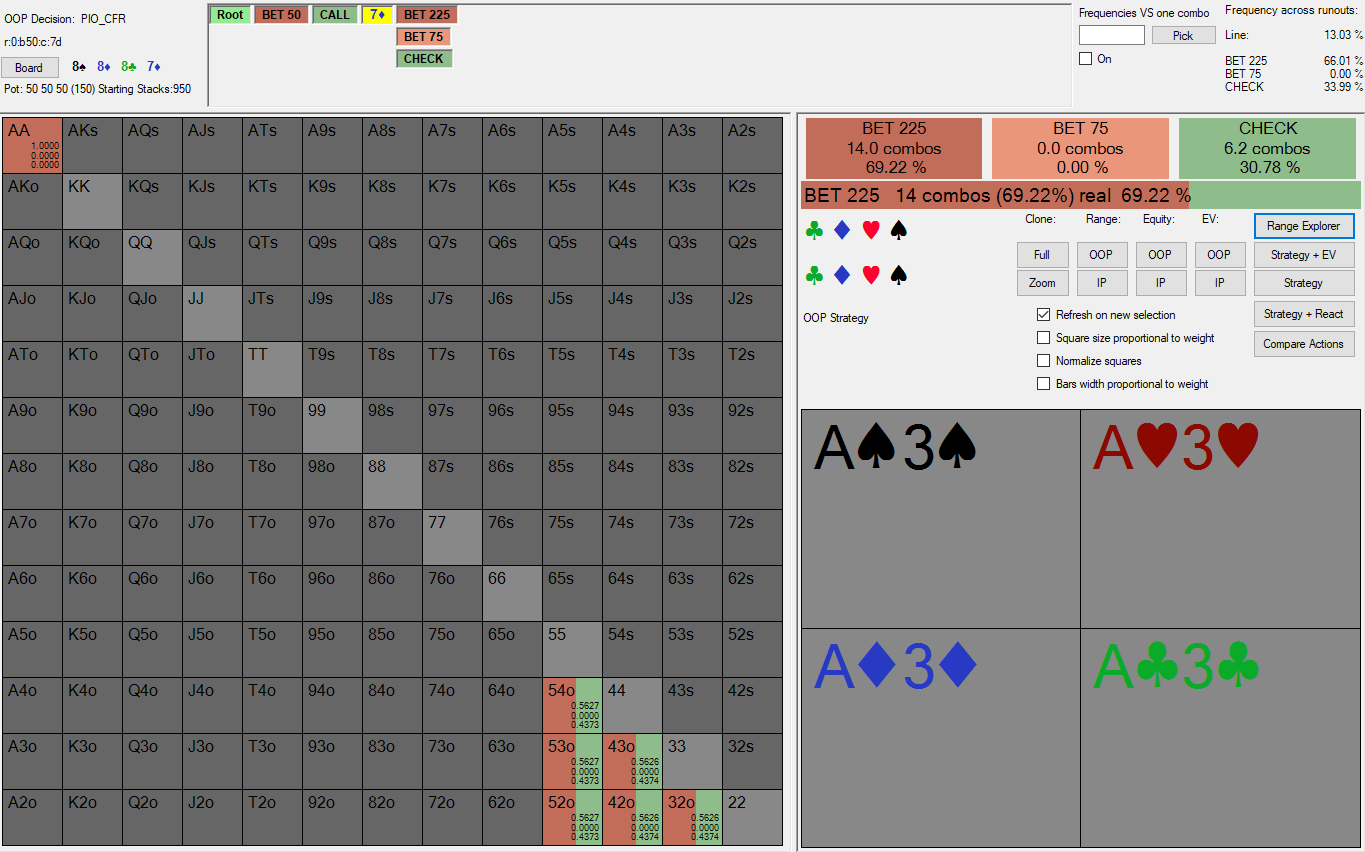
Turn blank OOP strategy
Never slowplay AA here, offsuit trash is drawing dead. Pretty much same scenario as 2/3/4/5 turn except we still have all our offsuit trash from the flop and thus need to give up a little more often. About 43% of our betting range is AA.
River Play
Any interesting rivers? I mean, not really…
- 8 turn and A river means both players always chop. No one’s ever folding. Same for A turn and 8 river
Maybe the most interesting spot is an A turn and A river. Here, the offsuit trash is chopping with KK. But AA is beating KK obviously. How do we determine KK EV here?
If AA makes up 300/975 which is ~31% of the shoving range, KK has a breakeven call with the stack sizes. The deeper stacks are, the more bluffs AA needs to have for KK to breakeven. Obviously if AA is underbluffing then KK always folds. If AA is overbluffing, KK has positive EV and is always calling, but it’s also never getting back more than half the pot. At best it’s chopping.
I believe OOP always adds all offsuit trash into its jamming range on the river.
Closing (Extremely Important) Musing - Is Mixing Necessary?
One concept that I’m still struggling to understand fully is mixing. In this sim, whenever KK is faced with a breakeven call/fold, it mixes its strategy between the two. But if calling and folding have the same EV, why can’t KK just always call or always fold? Does it need to mix at a specific frequency?
Well, I ran a sim where I node locked KK’s flop calling frequency at 75% instead of 50% and it turns out, it does matter:
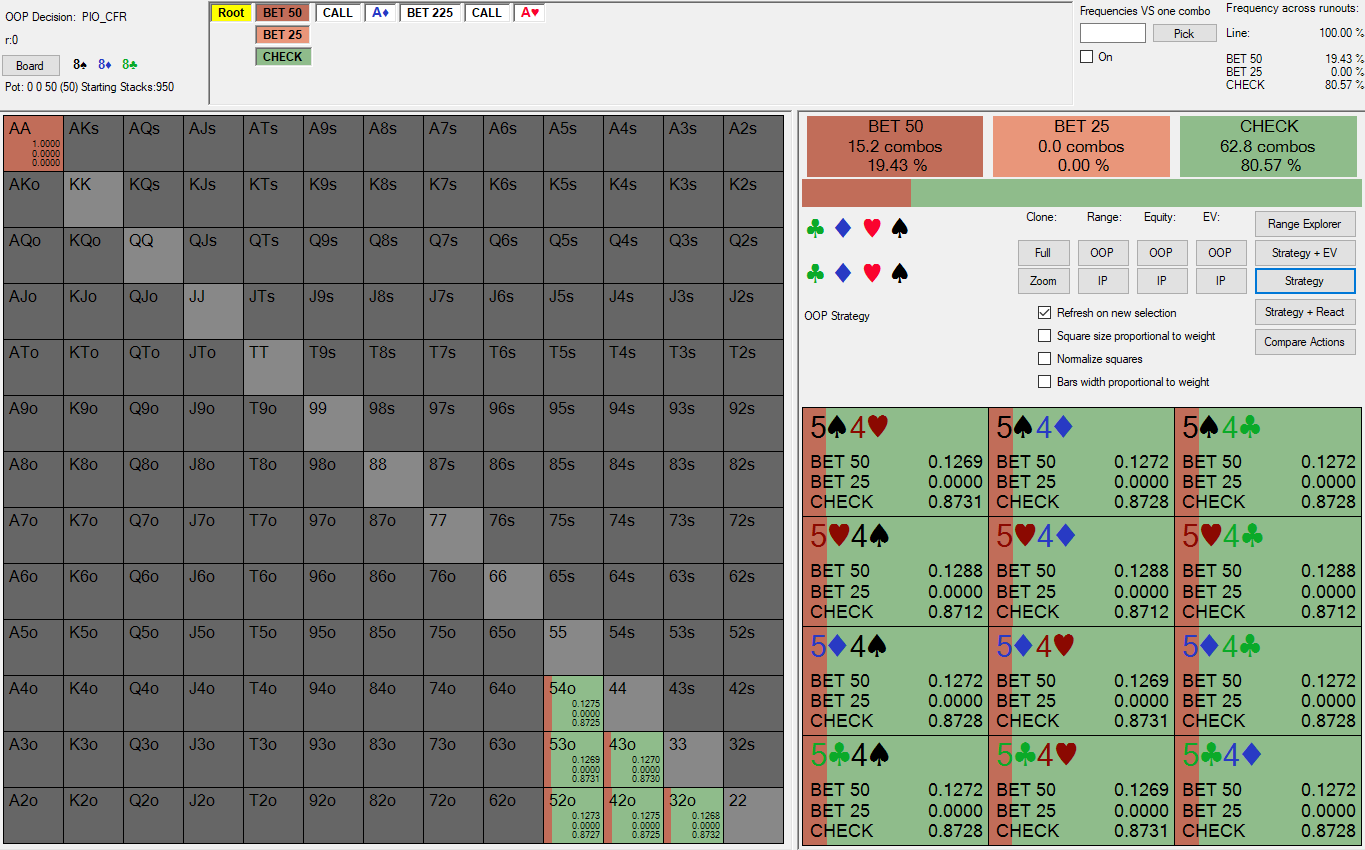
Flop OOP strategy against KK 75 percent call node lock
Running a sim where KK always calls on the flop, I got another surprise. I thought we would never bet our offsuit air and only bet with AA. But it turns out we bet some offsuit air. It makes sense because while KK never fold on the flop, KK will still fold on the turn and river, so we bring some offsuit air with us (but not as much) to bet together with AA so we can increase our winnings on later streets.
But another surprising thing is that the amount of offsuit air we bring along is exactly the same as when I node locked KK to call at 75% frequency. I thought it would be different. I thought there was some calculation I could use to connect these two numbers.
I then tried running the sim where KK always folds, and unsurprisingly we always bet our offsuit trash:
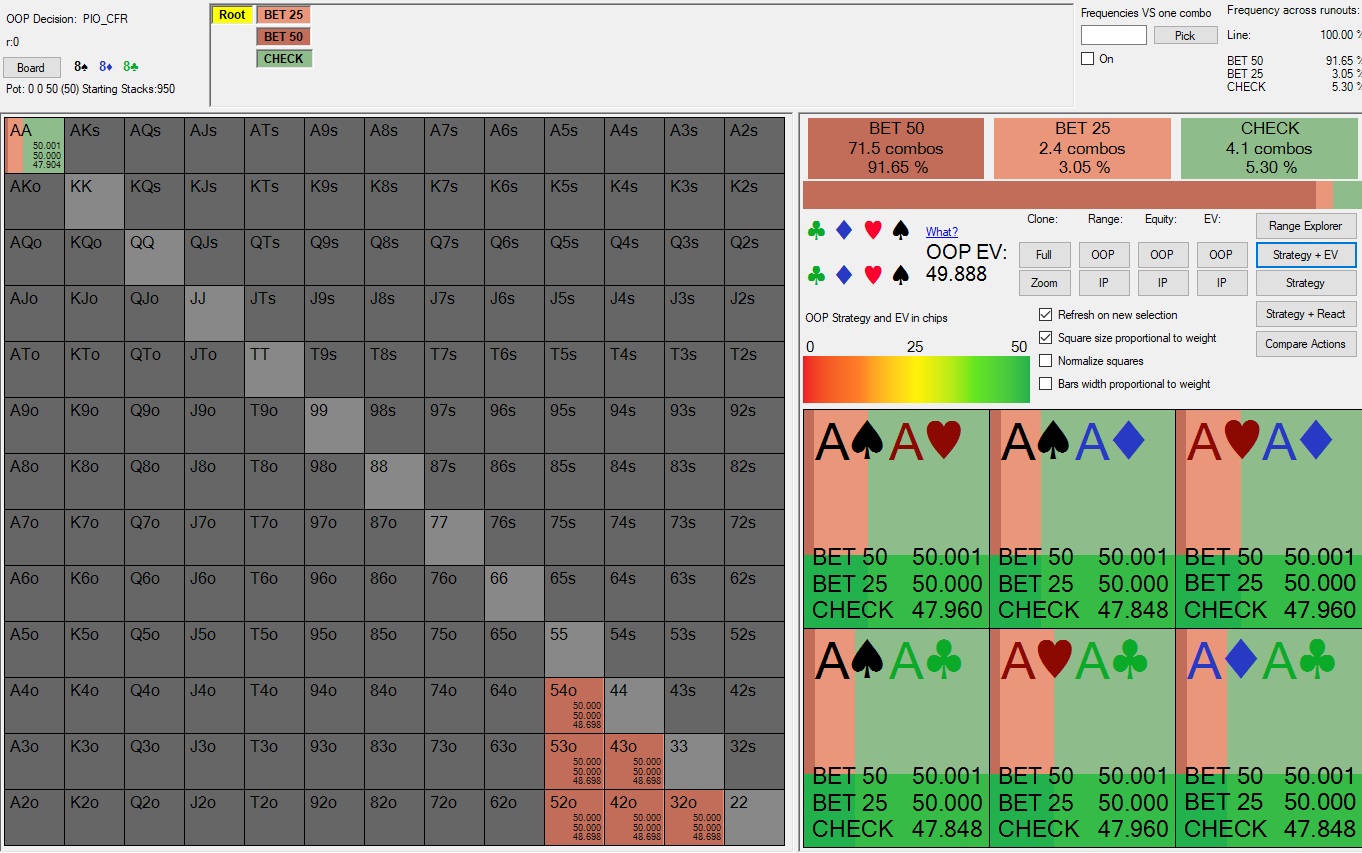
Flop OOP strategy against KK always folding node lock
Surprisingly we check back AA at some frequency according to the solver but I’m pretty sure this is a bug. There’s no reason AA would ever accept a lower EV than 50 when it could just bet and win 50 right then and there.
But then I tried running the sim with KK folding at a 75% frequency, and it turns out the strategy is exactly the same as when KK is folding at 100% frequency - betting its entire range:
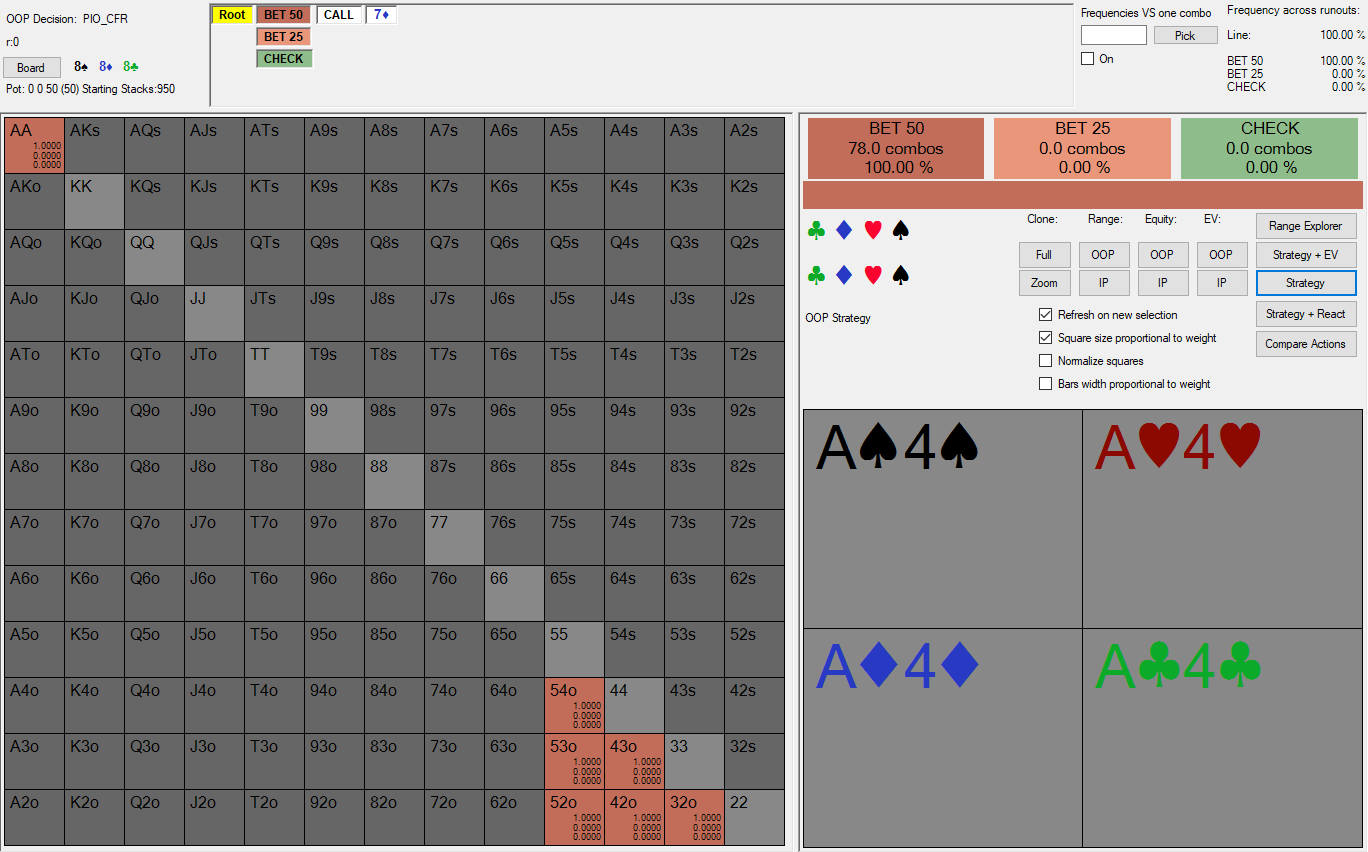
Flop OOP strategy against KK 75 percent fold node lock
This should give us an interesting look into how the solver thinks about the game. Whenever our opponent leans slightly in one direction (overcalling or overfolding) the solver will then maximally adjust the strategy in the other direction to maximize EV.
Summary
Well, after going through the work covered in this blog post, I’m actually surprised at how many variables are at play here, even on a really simple toy game with simple ranges and a blank flop.
This toy game can actually become a lot more complex if we just add a few different hands in the preflop ranges, or make the flop interact with the ranges more.
Really makes you realize that normal poker hands have so many variables coinciding with each other that it’s quite difficult to tangle them apart and understand what’s going on. Without theory it’s easy to end up trying to pattern match, creating (really) rough heuristics, and rationalizing instead of reasoning about things.
One should definitely understand these toy games like the back of your hand if you want to be good at poker. But, it’s so much work!